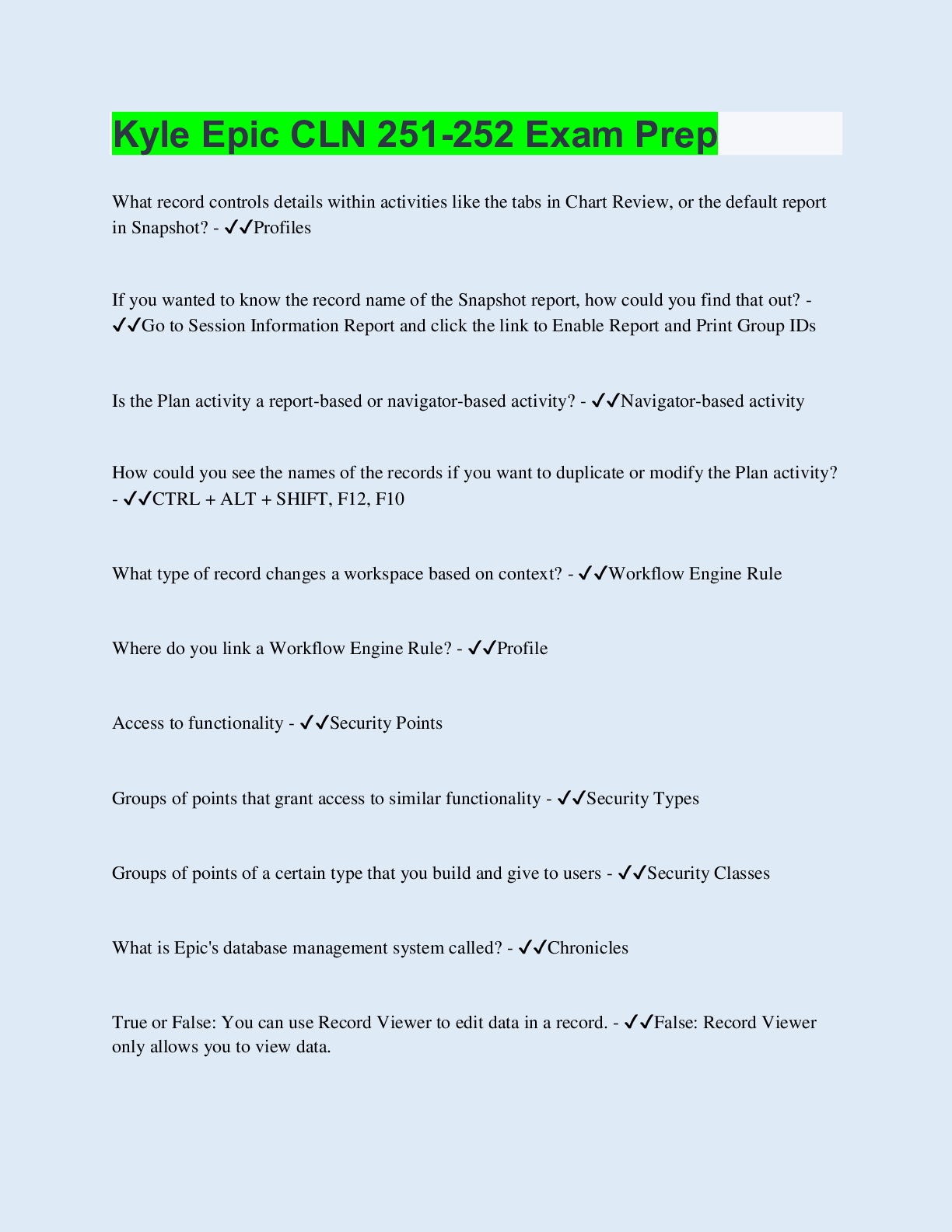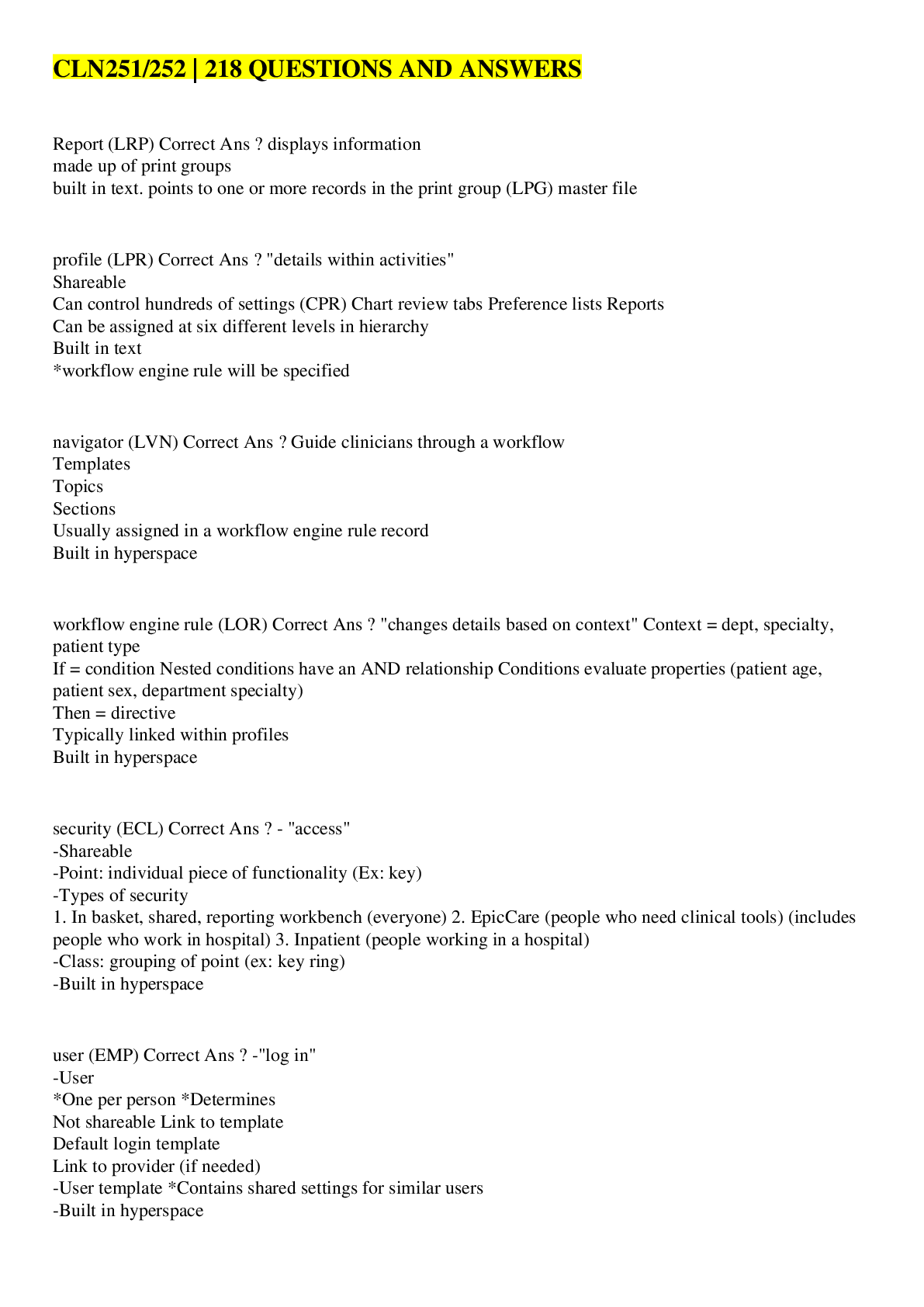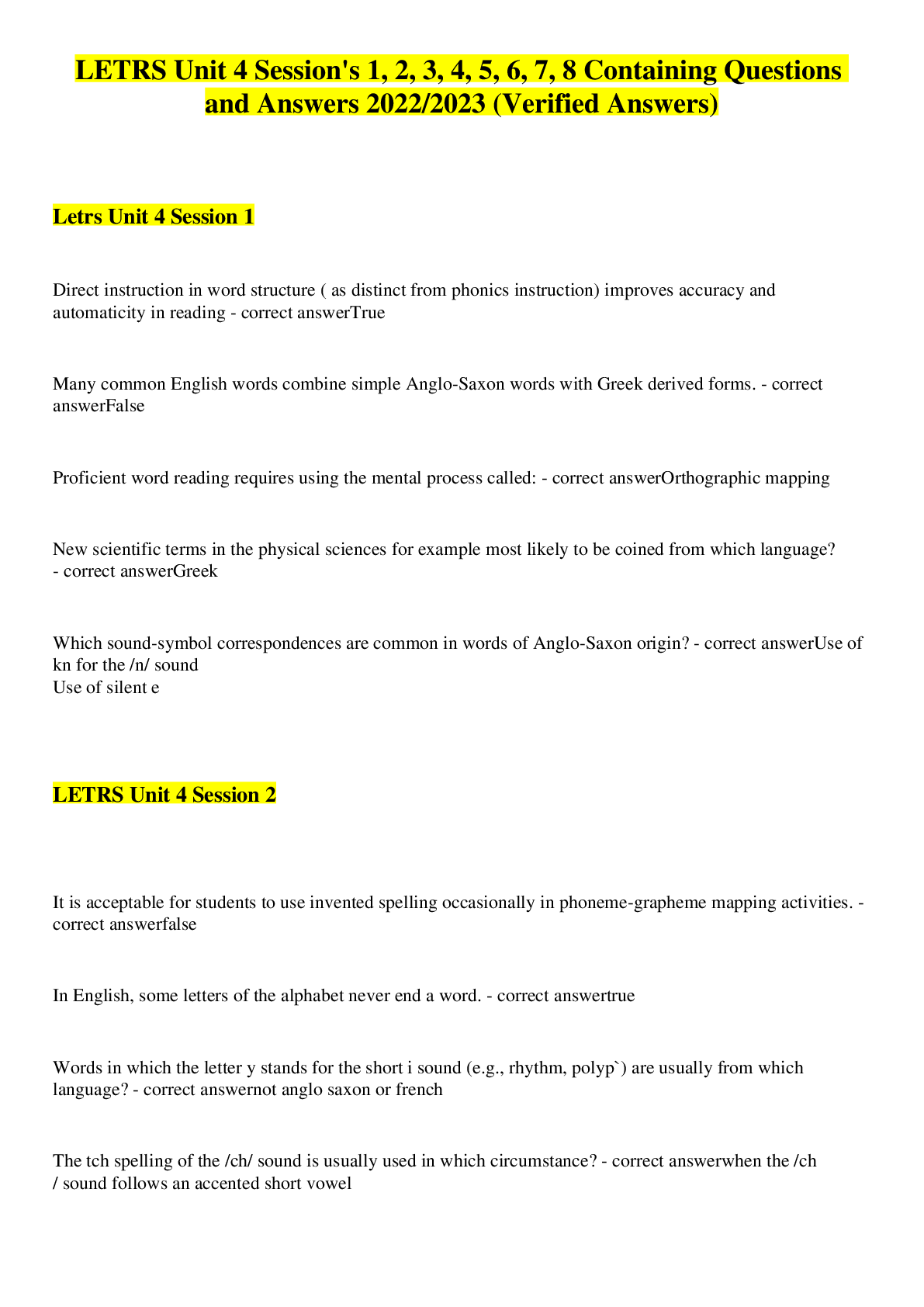*NURSING > EXAM > ATI Form A Women & Newborn Health complete exam practice questions and answers 70/70 graded A+ solu (All)
ATI Form A Women & Newborn Health complete exam practice questions and answers 70/70 graded A+ solution
Document Content and Description Below
1 Women & Newborn Health ATI –Form A 1) A client and her partner ask the nurse for information about permanent contraception. Which of the following statements should the nurse include in the co... unseling? a. Most sterilization procedures are considered irreversible b. A woman should use contraception for 1-2 months after a tubal ligation c. A man is usually sterile immediately after a vasectomy d. The menstrual cycle is shorter after a tubal ligation 2) A nurse is planning care for a newborn who has neonatal abstinence syndrome. Which of the following interventions should the nurse include in the plan of care? a. Swaddle the newborn in a flexed position b. Weigh the newborn every other day c. Increase the newborn’s visual stimulation d. Discourage parental interaction until after a social service evaluation 3) A nurse is providing teaching about increasing dietary fiber to an antepartum client who reports constipation. Which of the following food selections has the highest fiber content per cup? a. Lentils b. Oatmeal c. Cabbage d. Asparagus 4) A nurse is teaching a client who is pregnant about a new prescription for iron supplements. Which of the following instructions should the nurse include in the teaching? a. Increase intake of foods rich in vitamin C b. Take an extra pill if you miss a dose c. Report black stools to the provider d. Drink 8 ox of milk with each pill 5) A nurse is caring for a preterm newborn immediately after delivery. Which of the following actions should the nurse take first? a. Dry the infant under the radiant warmer b. Take the infant’s temperature c. Weigh the infant d. Obtain the infant’s blood glucose 6) A nurse is discussing family planning with a client who has a history of DVT. The nurse should inform the client that this condition is a contraindication for which of the following birth control methods? a. Oral contraceptive b. Cervical cap c. Diaphragm d. Intrauterine device 7) A nurse is teaching a client who is postpartum about car seat safety. Which of the following statements indicates and understanding of the instructions? 2 a. I will make sure the retainer clip is at the level of my baby’s abdomen b. I will position the car seat in the front passenger seat facing the font of the car c. I will adjust the angle of the car seat so that my baby sits at a 90-degre angle d. I will place the shoulder harness slightly below my baby’s shoulders 8) A nurse is monitoring a newborn whose mother reports recent opiate use for neonatal abstinence syndrome. Which of the following findings indicates narcotic withdrawl? a. Excessive Crying b. Unequal pupils c. Respiratory rate of 50/min d. Hypotonia 9) A nurse is assessing the reflexes of a term newborn. After placing the newborn in the supine position, which of the following methods should the nurse use to elicit the Moro reflex? a. Make a loud noise above the newborn b. Touch the newborn’s cheek with a finger c. Turn the newborn’s head to one side d. Tap the newborn’s forehead with a finger 10) A nurse is providing teaching to a client who is postpartum about her car seat safety. Which of the following statements by the client indicates an understanding of the teaching? a. I will ensure that my baby is at a 45-degree angle in the car seat b. I will put my baby facing forward in the middle of the back seat of the car c. I will fasten the harness clip 1 inch above my baby’s underarms d. I will swaddle my baby in a blanket before placing her in the car seat 11) A nurse is teaching a client who is breastfeeding and has mastitis. Which of the following statements by the client indicates an understanding of the teaching? a. I should apply a warm compress after feeding b. I should apply lanolin to the infection site daily c. I should use a nipple shield while breastfeeding d. I should stop breastfeeding until the infection has healed 12) A nurse is caring for a client following a vaginal delivery of a term fetal demise. Which of the following statements should the nurse make? a. You can bathe and dress your baby if you’d like to b. You should name the baby so he can have an identity c. If you don’t hold the baby, it will make letting go much harder d. Im sure you will be able to have another baby when you’re ready 13) A nurse is performing an initial assessment of a newborn who was delivered with a nuchal cord. Which of the following clinical findings should the nurse expect? a. Facial petechiae b. Erythema toxicum c. Periauricular papillomas d. Telangilectatic nevi 14) A charge nurse is discussing STIs with a newly licensed nurse. Which of the following infections should the nurse include in the teaching as an indication for a cesarean birth? a. HIV b. Chlamydia 3 c. Gonorrhea d. Syphilis 15) A nurse is reviewing the medication prescriptions for a newborn who is 6 hours old and whose mother is HBsAg-positive. The nurse should anticipate administering which of the following medications? a. Hepatitis B Immune Globulin b. Hepatitis A immune globulin c. Haemophilus inflenzae type B vaccine d. Hepatitis A vaccine 16) A nurse is assessing a client immediately following the placement of an epidural. The nurse obtains a maternal blood pressure of 96/54 and a fetal HR of 102/min. Which of the following actions should the nurse take? a. Position the client in a lateral position b. OR administer naloxone to the client??? c. Prepare the client for an amnioinfusion d. Place the client in knee-chest position 17) A nurse is planning care for a full-term newborn who is receiving phototherapy. Which of the following actions should the nurse include in the plan of care? a. Avoid using lotion or ointment on the newborn’s skin b. Dress the newborn in lightweight clothing c. Keep the newborn supine throughout treatment d. Measure the newborn’s temperature every 8 hours 18) A nurse on the labor and delivery unit is caring for a client who is at 33 weeks of gestation and was admitted with placenta previa. Which of the following interventions should the nruse include in the client’s plan of care? a. Administration of magnesium sulfate b. Routine vaginal exams c. Ambulation as tolerated d. Nonstress test twice weekly 19) A nurse is admitting a client who is in preterm labor to the labor and delivery unit. The nurse should anticipate which of the following tests to assess for fetal lung maturity? a. L/S ratio b. Direct coombs test c. Biophysical prophile d. Chorionic villus sampling 20) A nurse is caring for a client who is in labor and prescribed an amnioinfusion. Which of the following findings is an indication for this? a. Variable decelerations b. Early decelerations c. Fetal macrosomia d. Increased uterine tone 21) A nurse is caring for a client who is postpartum following repair of a vaginal laceration. The client has a firm fundus, moderate lochia rubra, and reports moderate perineal discomfort and pressure. Which of the following actions should the nurse take? 4 a. Check the perineal area b. Perform deep fundal massage c. Obtain vaginal culture d. Administer methylergonovide 0.2 mg IM 22) A nurse is assessing a full-term newborn 1 hr following a vaginal birth. Which of the following is an expected assessment finding? a. The newborn’s anterior fontanel bulges when he is quiet b. The newborn’s head circumference is greater than the chest circumference c. The newborn exhibits apneic episodes of 30 seconds d. The newborn has a heart rate of 70/min while sleeping 23) A nurse is providing discharge teaching to the parent of a newborn about surgical site care following circumcision using a clamp technique. Which of the following statements by the parent indicates an understanding of the teaching? a. I will check the site hourly for bleeding b. I will remove the crust with each diaper change c. I will wash the penis with soap and water daily d. I will apply petroleum jelly to the area with each diaper change 24) A nurse in a provider’s office is caring for a 20-year-old client who is 12 weeks of gestation and requests an amniocentesis to determine the gender of the fetus. Which of the following responses should the nurse make? a. You cannot have an amniocentesis until you are at least 35 year of age b. This procedure determines if your baby has genetic or congenital disorders c. Your provider will schedule a chorionic villus sampling to determine the sex of your baby d. We can schedule the procedure for later today if you’d like 25) A nurse is teaching a prenatal client about listeriosis and dietary modifications during pregnancy. Which of the following statements by the client indicates an understanding of the teaching? a. I can have a mid-day snack with soft cheese b. I can purchase a seafood salad from the grocery store c. I can still have a hot dog at the ballpark d. I can eat grilled chicken on a bun at lunch time 26) A nurse is providing education to a client who is to receive misoprostol for induction of labor. Which of the following instructions should the nurse include in the teaching? a. You will lie on your side for 40 minutes after I administer the medication b. I will insert a urinary catheter before I administer the medication c. I will begin an oxytocin infusion within 2 hours of your last dose of medication d. You will receive an antacid containing magnesium before the medication 27) A nurse is reviewing the laboratory findings of a client who is 10 weeks gestation. Which of the following findings should the nurse report to the provider? a. WBC 10,000 b. Hemoglobin 12 g/dL c. Creatinine 0.5 mg/dL d. Platelets 100,000 5 28) A nurse on the postpartum unit is reviewing prevention of newborn diaper rash with a client. Which of the following statements indicates an understanding of the teaching? a. I will allow the diaper area to dry before applying a clean diaper b. I will wash the diaper area with an antibacterial soap with each diaper change c. I will clean the diaper area with a scented baby wipe d. I will apply a thin layer of talc to the diaper area twice a day 29) A nurse is caring for a client who is in active labor. The nurse administers butorphanol IV bolus for pain. Which of the following findings should the nurse report to the provider following this medication? a. Respiratory rate 10/min b. Moderate fetal heart rate variability c. Urinary output 120mL in 2 hr d. Blood pressure 136/88 30) A nurse is caring for a client who is 1 day postpartum and breastfeeding her newborn. The client reports sore nipples. Which of the following actions should the nurse take? a. Have the client limit the length of breastfeeding to 5 min per breast b. Assess the newborn’s latch while breastfeeding c. Instruct the client to wait 4 hours between daytime feedings d. Offer supplemental formula between the newborn’s feedings 31) A nurse is caring for a client who is in the second stage of labor. The nurse observes the fetal head retract against the client’s perineum immediately following emergence. Which of the following actions should the nurse take? a. Assess fetal position using Leopold maneuvers b. Apply pressure to the client’s suprapubic area c. Reposition the client in the left lateral position d. Empty the bladder using crede maneuver 32) A nurse is admitting a client to the birthing unit who reports her contractions started 1 hour ago. The nurse determines the client is 80% and 8cm. The nurse realizes that the client is at risk for which of the following conditions a. Ectopic pregnancy b. Postpartum Hemorrhage c. Incompetent cervix d. Hyperemesis gravidarum 33) A nurse is assessing a client who is at 37 weeks gestation. Which of the following statements by the client requires immediate intervention by the nurse? a. I have been seeing spots this morning b. My feet are really swollen today c. I didn’t have lunch today, but I had breakfast this morning d. It burns when I urinate 34) A nurse is caring for a client who is in the second stage of labor. Which of the following manifestations should the nurse expect? a. The client expels the placenta b. The client delivers the newborn c. The client begins having regular contractions 6 d. The client experiences gradual dilation of the cervix 35. A nurse is assessing the fetal heart rate for a client who is at 38 weeks of gestation. When using an ultrasound device, the nurse hears blood rushing through the umbilical vessels in synchronization with the fetal heart beat. Which of the following terms should the nurse use to document this finding? a. Goodell’s sign b. Funic soufflé c. Hegar’s sign d. Quickening 36. A nurse at an antepartum clinic is caring for four clients. Which of the following clients should the nurse assess first? a. A client who is at 36 weeks of gestation and reports back pain following intercourse b. A client who is at 10 weeks of gestation and reports frequent urination c. A client who is at 24 weeks of gestation and reports periodic tingling of the fingers d. A client who is at 8 weeks of gestation and reports severe vomiting 37. A nurse is caring for four clients. For which of the following clients should the nurse auscultate the fetal heart rate during the prenatal visit? a. A client who has a crown-rump length of 7 weeks of gestation b. A client who has an ultrasound that confirms a molar pregnancy c. A client who has felt quickening for the first time d. A client who has a positive urine pregnancy test 1 week after missed menses 38. A nurse is assessing a newborn who is 2 hours old. Which of the following findings should the nurse report to the provider? a. Transient nystagmus b. Overlapping sutures with molding c. Single transverse palmar crease bilaterally d. Lanugo on the pinna of the ears 39. A nurse is reviewing the laboratory report of a client who is 24 hrs postpartum vaginal delivery. The client has a hemoglobin level of 9.0 g/dL and hematocrit of 25%. Which of the following actions should the nurse take? a. Prepare the client for a blood transfusion b. Initiate IV access for isotonic solution with an 18-gauge catheter c. Administer an iron supplement to the client d. Instruct the client that the provider will check for placental fragments 40. A nurse is caring for a client who is at 24 weeks of gestation and has a glucose screening test result of 150 mg/dL. Which of the following actions should the nurse take? a. Perform a urine screen for ketones b. Repeat the glucose screening test in 15 min to verify results c. Schedule the client for a 3 hr oral glucose tolerance test d. Determine if the client has fasted 7 41. A nurse is assessing the results of a non-stress test for an antepartal client at 35 weeks of gestation. Which of the following findings should indicate to the nruse the need for further diagnostic testing? a. An increase in fetal heart rate to 150/min above the baseline of 140/min lasting 10 seconds in response to fetal movement within a 40-min testing period b. Irregular contractions of 10 to 20 seconds in duration that are not felt by the client c. No late decelerations in the fetal heart rate noted with three uterine contractions of 60 seconds in duration within a 10-min testing period d. Three fetal movements perceived by the client in a 20-min testing period 42. A nurse is caring for a client who is receiving oxytocin to induce labor. The nurse should discontinue the oxytocin if which of the following occurs? a. Six contractions in 10 min b. Nonrepetitive early decelerations c. Moderate variability of the fetal heart rate d. Contractions last 60 seconds 43. A nurse is caring for a client who has had a pudendal nerve block. The nurse should monitor for which of the following findings as an adverse effect? a. Decreased ability to bear down b. Uterine hyper-stimulation c. Fetal bradycardia d. Maternal hypertension 44. A nurse is assessing a newborn following a vaginal delivery. Which of the following findings should the nurse report to the provider? a. Bulging fontanels b. Subconjunctival hemorrhage c. Milia d. Caput succedaneum 45. A nurse is caring for a client who is 1 day postpartum following the birth of her first baby. The client’s partner states, “I’ve been having nightmares that we are homeless and the baby is starving.” Which of the following is an appropriate response by the nurse? a. This is just the beginning of the worrying you will do as a parent b. I know you’re worried, but everything is going to be okay c. What do you think it will be like to be responsible for a baby? d. Why would you worry about being homeless when you have a good job? 46. A nurse is providing discharge instructions to a client who delivered a newborn via cesarean birth 4 days ago. The nurse should instruct the client to contact the provider for which of the following findings? a. The newborn’s cord stump is still attached after 1 week b. The newborn has fewer than four wet diapers in 24 hr c. The newborn has loose stools d. The newborn sleeps 16 hr a day 8 47. A nurse is caring for a newborn. Which of the following assessment findings should indicate to the nurse that suctioning of the nasopharynx is needed? a. The newborn is beginning to cough b. The newborn’s respiratory rate is irregular c. The newborn’s pulse oximetry is 91% d. The newborn’s respiratory rate is 32/min 48. A nurse is performing a physical examination of a term newborn upon admission to the nursery. In which order should the nurse perform the following assessments? (Move the steps into the box on the right, placing them in the selected order of performance. Use all the steps.) – PUT THEM IN ORDER Observe the newborn’s respirations Auscultate the newborn’s heart rate Auscultate the newborn’s abdomen Test the newborn’s reflexes 49. A nurse in a prenatal clinic is discussing quickening with a client who is in the first trimester of her first pregnancy. Which of the following statements by the client indicates understanding of the teaching? a. I will plan to have a blood test when quickening occurs b. I will feel movement at about 16 to 20 weeks c. I will begin scheduling appointments every 2 weeks d. I will take two ibuprofen capsules for the discomfort 50. A nurse is assessing a full-term newborn upon admission to the nursery. Which of the following clinical findings should the nurse report to the provider? a. Rust-stained urine b. Transient circumoral cyanosis c. Subconjunctival hemorrhage d. Single palmar creases 51. A nurse is assessing a client who is in her second trimester for common physiological changes during pregnancy. The nurse notes a blotchy discoloration on the client’s forehead, nose, and cheeks. Which of the following changes should the nurse document? a. Striae gravidarum b. Epulis c. Chloasma d. Linea nigra 52. A nurse is conducting a class for a group of clients about birth control. Which of the following information should the nurse include in the teaching? a. You should have an annual examination to assess your diaphragm b. You should use spermicide 3 hours prior to sexual intercourse c. Your fertility will return 6 months after your provider removes your IUD d. You will not need to use birth control for 1 month after receiving emergency contraception 9 53. A nurse is caring for a client who is in the first stage of labor and the fetal head is in a posterior position. The client reports pressure and pain in her lower back. Which of the following nonpharmacological comfort measures should the nurse suggest first? a. Guided imagery b. Effleurage c. Patterned breathing d. Counterpressure 54. A nurse is monitoring a client who has preeclampsia and is receiving magnesium sulfate by continuous IV infusion. Which of the following findings should the nurse report to the provider? a. Urinary output 20 mL/hr b. 2+ deep tendon reflexes c. Blood pressure 148/94 mm Hg d. Respiratory rate 14/min 55. A nurse is caring for a client who has preeclampsia and is receiving magnesium sulfate by continuous IV infusion. The nurse should monitor for which of the following adverse effects? a. Hypertonia b. Elevated blood pressure c. Polyuria d. Absence of deep tendon reflexes 56. Question about identifying a graph that shows a prolonged deceleration. Needs image to answer. – IGNORE THIS 57. A nurse is providing teaching to the parents of a newborn about the Plastibell circumcision technique. Which of the following information should the nurse include? a. Yellow exudate will form at the surgical site in 24 hours b. The Plastibell will be removed 4 hours after the procedure c. Make sure the newborn’s diaper is snug d. Notify the provider if the end of your baby’s penis appears dark red 58. A nurse is reviewing a client’s rubella titer of 1:8 at her second prenatal visit. Which of the following statements by the nurse is appropriate? a. You will need a rubella immunization at your next prenatal visit b. Your titer indicates that you are susceptible to rubella c. Because rubella is a live vaccine, you will not be able to breastfeed your newborn d. During your third trimester, you will need to repeat a blood test for the titer 59. A nurse is caring for a client who is in active labor and is receiving oxytocin via IV infusion. The nurse has applied an internal fetal heart monitor and recognizes an early deceleration of the fetal heart rate tracing. Which of the following actions should the nurse take? a. Discontinue the oxytocin b. Assist the client to lay on her right side c. Administer oxygen at 8 L/min per mask 10 d. Continue to monitor the client 60. A nurse in a postpartum unit is caring for several clients. Which of the following tasks should the nurse delegate to assistive personnel? a. Help the client with perineal care b. Demonstrate to a client how to change a diaper c. Check the saturation of the perineal pad d. Provide the client with a dose of magnesium hydroxide 61. A nurse is providing discharge teaching to a client following tubal ligation. Which of the following statements by the client indicates an understanding of the teaching? a. Premenstrual tension will no longer be present b. Ovulation will remain the same c. Hormone replacements will be needed following this procedure d. My monthly menstrual period will be shorter 62. A nurse is caring for a client who is in the latent phase of the first stage of labor and is in pain. Which of the following nursing interventions are appropriate to reduce pain? (Select all that apply.) a. Administer 70% nitrous oxide mixed with oxygen b. Perform Leopold maneuvers c. Have the client sit in a tub of warm water d. Ambulate the client in the hallway e. Apply counterpressure to the sacral area 63. A nurse in a provider’s office is assessing a client at her first antepartum visit. The client states that the first day of her last menstrual period was March 8. Use Nagele’s rule to calculate the estimated date of delivery. (Use the MMDD format with four numerals and no spaces or punctuation.) 1215 64. A nurse in a prenatal clinic is reviewing the laboratory results for a client who is at 12 weeks of gestation. Which of the following actions should the nurse take? (Click on the “Exhibit” button for additional information about the client. There are three tabs that contain separate categories of data.) THIS QUESTION REQUIRES “EXHIBIT” HEARING, SO SINCE YOU CAN’T LISTEN, USE YOUR BEST JUDGMENT TO ANSWER THIS, POSSIBLY. a. Administer rubella vaccine b. Obtain a blood culture c. Administer ceftriaxone IM d. Obtain a maternal serum alpha-fetoprotein specimen 65. A nurse is providing discharge instructions to a client who is breastfeeding her newborn. Which of the following instructions should the nurse include? a. Expect two to four wet diapers every 24 hr b. Offer the newborn 30 mL (1 oz) of water between feedings c. Feed the newborn 5 to 10 min per breast 11 d. Allow the baby to feed at least every 3 hr 66. A nurse is assessing a client who is 1 hr postpartum. The nurse notes a large amount of vaginal bleeding with several large blood clots on the client’s peripad. The client’s blood pressure is 70/42 mm Hg and her heart rate is 150/min. Which of the following actions should the nurse take first? a. Massage the fundus b. Apply oxygen at 10 to 12 L/min c. Elevate the legs d. Administer an IV bolus of oxytocin 67. A nurse is assisting the provider to administer a dinoprostone (Cervidil) insert to induce labor for a client. Which of the following actions should the nurse take? a. Instruct the client to avoid urinary elimination until after administration b. Allow the medication to reach room temperature prior to administration c. Place the client in a semi-Fowler’s position for 1 hr after administration d. Verify that the informed consent is obtained prior to administratin 68. A nurse is planning care for a newborn who is large for gestational age due to maternal gestational diabetes mellitus. The nurse should recognize that the newborn is at risk for which of the following conditions? (Select all that apply.) a. Hyperbilirubinemia b. Hypercalcemia c. Polycythemia d. Hypomagnesemia e. Hypoglycemia 69. A nurse is providing prenatal teaching to a group of clients who are in their third trimester of pregnancy. Which of the following statements by a client indicates an understanding of the teaching? a. I should lie on my back as much as possible during the labor process b. Panting will help me control the urge to push when my cervix is not completely dilated c. I will be allowed to start to push once my cervix is dilated to 5 centimeters d. Once my water has broken, I will not be able to have epidural anesthesia 70. A nurse manager on the labor and delivery unit is teaching a group of newly licensed nurses about maternal cytomegalovirus. Which of the following information should the nurse manager include in the teaching? a. Mothers will receive prophylactic treatment with acyclovir prior to delivery b. Lesions are visible on the mother’s genitalia c. Transmission can occur via the saliva and urine of the newborn d. This infection requires airborne precautions are initiated for the newborn 12 Type B 1. A nurse is assessing a postpartum client who is receiving oxytocin 1 hr. after a normal spontaneous delivery. During the assessment, the nurse notes that the client perineal pad is fully saturated. which of the following actions should the nurse anticipate taking? A. Insert vaginal packing B. Discontinue the oxytocin infusion C. Administer terbutaline sulfate D. Massage the uterus until firm 2. A nurse is providing teaching to a client who has mild preeclampsia and will be caring for herself which statement by the clients indicates an understanding of the teaching? A. I will check my urine for protein only B. I will consume 50 grams of proteins daily C. I will alternate the arm I use to check my blood pressure D. I will count my baby kicks every other day 3. A nurse is assessing a client and observes the umbilical cord protruding from the vaginal , after calling A. Administer oxygen via nonrebreather facemask B. Wrap the cord with a sterile towel saturated in normal saline C. Place a rolled towel under the clients right hip. D. Apply upward pressure against the presenting part. 4. A nurse is reviewing the laboratory results of a client who is at 20 weeks of gestation and has type 1 diabetes mellitus. Which of the following report to the provider? A. Hct 34% B. Platelets 170,000/mm^3 C. BUN 25 mg/dL D. HbA1c 6% 5. A nurse on the labor and delivery unit is assessing four clients. Which of the following clients is a candidate for an induction of labour A. A client who has gestational diabetes mellitus B. A client who has placenta plavia C. A client who has active genital herpes D. A client who has a previous uterine incision. 6. A nurse is providing discharge instructions to a client who is breastfeeding her newborn. Which of the following A. Allow the baby to feed at least every 3 hr. B. Offer the new born 30ml (1 oz.) of water between feeding C. Feed the newborn 5 to 10 min per breast D. Expect two to four wet diapers every 24 hrs 7. A nurse is caring for a client who is at 8 weeks of gestation and has an ectopic pregnancy. A. Bright, red vaginal discharge B. Scaphoid abdomen 13 C. Elevated blood pressure D. Sharp pelvic pain 8. A nurse is providing education about RH(D) immune globulin to a client who is pregnant. What indicate for administering RH(D)immune globulin? A. The client delivers an Rh-negative newborn B. The client has a history of placenta previa C. The client had a spontaneous abortion D. The client is at 16 weeks of gestation. 9. A nurse is providing teaching to a client who is 2 days postpartum. A. You should store your diaphragm in sterile water after each use B. You should use an oil based vaginal lubricant when inserting your diaphragm C. You should have your provider refit you for a new diaphragm D. You should keep the diaphragm in place for at least 4 hours after intercourse. 10. A nurse is caring for a client who is 12hr. postpartum and has a fourth degree laceration of the perineum A. Apply a moist , warm compress to the perineum B. Apply provide iodine to the client perineum after the voids C. Provide the client with a cool sitz bath D. Administer methyfergenevine 0.2 mg 11. A nurse is assessing four newborns. Which of the following clinical findings… A. A 2 day old infant who is excreting a thin, white discharge from both nipples B. A 2 day old infant who has a respiratory rate of 70/mims C. A 16 hr old infant who has a blood glucose level of 50 mg/dl D. A 16 hr old infant who has yet to pass a meconium stool 12. A nurse is performing an initial assessment of a new born who was delivered with a nuchal cord. A. Telanglectatic nevi B. Facial petechiae C. Erythema toxicum D. Periauricular papilloma 13. A nurse is assisting the provider to administer a dinoprostone insert to induce labor A. Verify that the informed consent is obtained prior to administration B. Place the client in a semi fowler position for 1 hr. after administration. C. Instruct the client to avoid urinary elimination until after administration D. Allow the mediation to reach room temp. prior to administration. 14.A nurse is assessing a new born 2 hr. after delivery. Which of the following findings in these image. 31. A nurse is caring for a client who is at 20 weeks of gestation and has trichomoniasis. Which of the following findings should the nurse expected? A. malodorous B. Urinary frequency C. vulva lesions 14 D. Thick, white vaginal discharge. 32. Calculation 33. A nurse is teaching a group of women who are pregnant about actions to take if they are suspect they are experiencing preterm labor the nurse provides. A. call your doctor if you have contractions every 20 minutes for at least 1 hour B. expect to have a small amount of fluid leaking from the vagina c. empty your bladder d. lie on your back for 2 hrs. 34. A nurse is admitting a client to the birthing unit who reports her contraction started 1hrs. ago. The nurse determine realizes that the client is at risk for which of the following conditions. A. Hyperremesis gravidarum B. Ectopic pregnancy C. Incompetent cervix D. postpartum hemorrhage. 35. A nurse is providing teaching to a postpartum client who has a prescription for a rubella immunization. Which of the A. I should avoid breastfeeding for 2 weeks following the immunization B. I will receive a series of three immunization and each one will be a month apart c. I should avoid becoming pregnant for at least 1 month following the immunization d. I will report joint pain that develop after the immunization to my provider immediately. 36. A nurse is caring for a newborn who is 2 days old. Which of the following finding should the nurse report. A. Edema of the scalp that crosses lines B. Bilirubin 17 mg/dl c. heart rate 180 min when crying d. presence of a babinski reflex 37. Teaching a client and her partner about the techniques of counter pressure during labor. Which of the following statement by the nurse is appropriate A. your partner will apply upward pressure on your lower abdomen between contractions B.Your partner will apply steady pressure with a tennis ball to your lower back c. your partner will apply continuous, film pressure between your thumb and index finger d. your partner will apply pressure to the top of your uterus during contraction. 38. A nurse is preparing the plan of care for a term newborn who was asymptomatic at birth and whose mother had hepatitis B. which intervention should the nurse include in the plan of care A. Administer hepatitis B immune globulin IM to the newborn B. initiate airborne precaution C. wait at least 24hrs. before bathing the new born d. instructs the mother to delay breast feeding for one week 39. A nurse is caring for a client who has preeclampsia and receiving magnesium sulfate. Which of the following clinic? A. increased fetal movement B. incresased urinary output c. increased respiratory rate d. increased muscle weakness. 40. A nurse is creating a plan of care for a client who is in active labor and has mitral valve ster\ A. administer 500ml of 0.9% sodium chloride solution every hour 15 B. maintain the client in the lithotomy position during labor. C. prepare the client for vacuum of forceps assisted birth D. Give the client 0.25g of terbutaline subcutaneously every 6 hrs. 41. A nurse is caring for a client who is at 28wks of gestation and received no immunization. What to administer? A. tetanus B.rubella C. variella D. human papillomavirus 42. A nurse in a provider office is caring for a 20yrs old client who is at 12wks of gestation ……the following responses should the nurse make A. we can schedule the procedure for later today if you d like B. you cannot have an amniocentesis until you are at least 35yrs of age c. this procedure determines if your body has genetics or congenital disorders d. your provider will schedule a chorionic villus sampling to determine the sex 43. A nurse is receiving the laboratory report of a client who is 24hr postpartum vaginal delivery. Which of the following actions should the nurse take first? A. initiate IV access for isotonic solution with an 18 gauge catherter B. prepare the client for a blood transfusion c. Instruct th client that the provider will check for placental fragment d. Administer an iron supplement to the client. 44. A nurse is assessing a full term newborn upon admission to the ………………. A. Rust stained urine B. Transient circumoral cyanosis c. subconjunctival hemorrhage d. single palmer creases 45. A nurse is caring for a client who is in preterm labor and receiving magnesium sulfate by review during tocolytic therapy. A. serum medication level B. Uric add level C. liver enzymes d. indirect coombs test. 46. A nurse is teaching a newly licensed nurse about the use of ultrasonography in the first trimester. The nurse indicates an understanding of the teaching. A. Ultrasound is used to observe for placental maturity in the first trimester B. Ultrasound is used to detect intrauterine growth restriction in the first trimester C. Ultrasound is used to determine gestational age in the first semester. D. ultrasound is used to perform a biophysical profile in the first triemester. 47. A nurse is preparing to perform a non stress test for a client who is at 34 week of gestation. Which………………….. A. Place the client in the supine position at the beginning of the test B. administer oxygen via facemask during the test C. Insert a peripheral IV catheter into the right arm before the test D. Record the fetal heart rate for 20 mins during the test. 48. A nurse is caring for a preterm newborn 18hrs. following delivery. After reviewing the newborn. On the exhibit button for additional information about the newborn . there are 3 tabs 16 A. initiate phototherapy or B. initiate gavage feeding C. administer oxygen D. administer an antibiotic Look into the exhibit first: Tab 1: heat rate is 136/mins., Respiratory rate is 44/mins, Axillary temperature 36.6 . Tab 2: cant see what is there Likewise Tab 3. 49. A nurse is providing teaching to a client who has phenylketonuria and wants to become pregnant. which of the following information should the nurse A. your doctor will monitor your phenylalanine levels twice weekly throughout your pregnancy B. your doctor will perform an amniocentesis right before delivery to test your baby for phenylketonuria c. you will need to increase your protein intake to 50 percent of your daily caloric intake d. you will need to undergo labor induction with oxytocin at 38 weeks of gestation. 50. A nurse is providing discharge teaching to a client whose new born is 2 days old. Which of the following statements by the client indicates an understanding A. l need to place the car seat facing forward in the back seat. B. I will suction my baby mouth before suctioning her nose C. l should apply alcohol to the area around my baby umbilical cord daily. D. I will be sure that my baby has at least 10 wet diapers per day 51. A nurse is discussing nonpharmacological pain management during labor with a client. Which of the following statement by the client indicates an understanding of the teaching.? A. The temperature of the water should be between 36 to 37 degrees Celsius when using hydrotherapy. B. I should use effleurage when I am pushing C. My partner can apply counter pressure to my upper abdomen for 10 seconds at a time D. I can apply a TENS unit to my lower abdomen to decrease the pain of my contractions 52. A nurse is assessing a client during her first prenatal visit. The client reports March 20 as her last menstrual period. Use Nagele rule to calculate the estimated date delivery. (use the MMDD format with four numerals and no spaces or punctuations Dec. 27……..1227 53. A nurse is caring for an infant who has signs of neonatal abstinence syndrome. Which of the following actions should the A. Provide a stimulating environment B. Monitor blood glucose level every hr. C. initiate seizure precautions D. place the infant on his back with legs extended Interventions: swaddle the newborn in a flexed position. 54. A nurse is reviewing a fetal heart monitor trading for a client who is at 39 weeks of gestation and is in labor. Which of the following will report to the provider? A. 130/mins. With moderate variability B. 150/min with absent variability c. 135/min with accelerations D. 155/min with occasional early deceleration 55. A nurse on the postpartum unit is caring for four clients. Which of the following clients should receive RH(D) 17 A. An Rh-positive mother who has an Rh-negative infant B. An Rh-positive mother who has an Rh-positive infant c. An Rh-negative mother who has an Rh-positive infant d. An Rh-negative mother who has an Rh-negative infant Special immune globulins, called RhoGAM, are now used to prevent RH incompatibility in mothers who are Rh-negative. If the father of the infant is Rh-positive or if his blood type is not known, the mother is given an injection of RhoGAM during the second trimester 56. A nurse is reviewing the medial record of a client who is requesting an oral contraceptive for birth control. The nurse should contraindication to the use of oral contraceptives for the client. A. Fasting blood glucose 100 mg/dl B. Heart rate 72/mins C. Blood pressure 118/78mmhg D. Aspartate aminotransferase 55 unit/s/l : Typically the range for normal AST is reported between 10 to 40 units per liter and ALT between 7 to 56 units per lite blood clots, high blood pressure, certain types of cancers, heart attack, stroke, liver disease, gallbladder disease, undiagnosed uterine bleeding, cardiac problems, epilepsy, sickle cell disease, chronic renal disease, smokers, prior to elective surgery, suspected pregnancy, obese women, certain types of migraine headaches, or uncontrolled diabetes. 57. A nurse is receiving report on four postpartum clients. Which of the following clients should the nurse plans to attend to A. A client who reports abdominal pain during breastfeeding B. A client who has a urine output of 250 mL in 6hrs. C. A client who reports changing her perineal pad every 2 hrs D. A client who has hyporeflexia while receiving IV magnesium sulfate 58. A nurse is providing teaching to a client who is primigravid and is scheduled to have an abdominal ultrasound understanding of the teaching A. I won’t apply perfumed lotion to my abdomen before the test. B. I will drink water before the test until my bladder feels full. C.I need to take a stool softener the night before the test d. I can’t have anything to eat after midnight 59. A nurse in a prenatal clinic is caring for a group of clients. The nurse should recognize that which of the following client has a contradiction A. A client who has gestational diabetes mellitus B. A client who had a previous stillbirth C. A client who had a non-reactive nonstress test D. A client who has a previous classical incision. 60. A nurse is caring for a newborn who was delivered 12 hrs ago. Which of the following findings indicate hypoglycemia? (select all that apply) A. Difficulty feeding B. Hypertonia c. jitteriness d. Acrocyanosis e. Blood glucose 75 mg/dl 61. A nurse is reviewing laboratory result for a client who is pregnant. Which of the following laboratory values to increase A. Bun 18 B. Bilirubin c. fasting blood glucose d. RBC count 62. A nurse is assessing a client following an amniocentesis. Which of the following should A. urinary tract infection B. polyhydracmnios c. leakage of amniotic fluid d. pretem labor e. amnionities 63. A nurse is caring for a client who is in pretem labor and receiving magnesium sulfate by continuous IV infusion. Which of the following indicates that the client is experiencing an adverse effect of the medication. A. Urinary output 20ml/hr B. Magnesium 7.2 Meg/l C. respiratory rate 15/mins D. Blood pressure 180/96 mmhg 64. A nurse is providing teaching about prenatal laboratory tests to a client who is 8 weeks of gestation. identify the sequence of routine screening (move the steps into the box on the right, placing them in the selected order of performance. Use all the step. 3.Maternal serum alpha fetoprotein level 4. Vaginal and anal culture for m B streptococcus & hemolytics 1.Testing for rubella titer 2.1-hour glucose tolerance tets. 65. A nurse is assessing a newborn whose mother has cocaine use order. Which of the following newborn finding should the nurse………………….. A. Increased head circumference B. increased cardiac output c. hypotention d. increased startle reflex. Remained 66 to 70 update you later atiWomen & Newborn Health ATI – Form C 1. A nurse is caring for a client who is 2 weeks postpartum following a cesarean birth. Which of the following clinical findings should the nurse identify as an indication of postpartum infection? ATI PAGE 143 a. Persistent abdominal striae b. Unilateral breast pain c. WBC count 12,000/mm^3 d. Lochia alba 2. A nurse is assessing a client who has preeclampsia during a prenatal visit. Which of the following should the nurse report to the provider? 19 a. Blood glucose 110 mg/dL b. Urine protein of 3+ c. Hemoglobin 13 g/dL d. Deep tendon reflexes of 2+ 3. A nurse is providing teaching about the expected effects of magnesium sulfate to a client who is at 28 weeks of gestation and has preeclampsia. Which of the following responses by the nurse is appropriate? ATI PAGE 61 a. This medication prevents seizures b. This medication stabilizes the fetal heart rate c. This medication increases cardiac output d. This medication improves tissue perfusion 4. A nurse is teaching a prenatal class regarding false labor. Which of the following information should the nurse include? ATI PAGE 76 a. You will have dilation and effacement of the cervix b. Your contractions will become temporarily regular c. You will have bloody show d. Your contractions will become more intense when walking 5. A nurse manager is revising a maternal unit policy to ensure proper identification of newborns. Which of the following should the nurse include in the policy? ATI PAGE 164 a. Check the newborn’s identification using the crib card b. Replace the infant’s identification band after his name has been recorded c. Require visitors to wear an identification band d. Obtain an imprint of the infant’s feet prior to taking him to the nursery 6. A nurse is caring for a client who delivered by cesarean birth 6 hr ago. The nurse notes a steady trickle of vaginal bleeding that does not stop with fundal massage. Which of the following actions should the nurse take? ATI PAGE 136 a. Replace the surgical dressing b. Administer 500 mL lactated ringer’s IV bolus c. Apply an ice pack to the incision site d. Evaluate urinary output 7. A nurse is providing discharge instructions to a client who is postpartum and has engorged breasts. Which of the following nonpharmacological comfort measures should the nurse include in the teaching? a. Wear nipple shields during the feeding b. Apply cabbage leaves after feedings c. Use a breast binder for 2 days d. Use plastic-lined breast pads 8. A nurse is calculating the estimated date of birth using Nagele’s rule for a client who is pregnant and whose last menstrual cycle started June 21. Which of the following is the estimated date of delivery in the next year? 20 a. March 14 b. March 28 c. March 21 d. April 4 9. A nurse is caring for a client immediately following the delivery of a stillborn fetus. Which of the following actions should the nurse take? ATI PAGE 40 a. Prepare the client for what to expect the fetus to look like b. Instruct the client that an autopsy should be performed within 24 hr c. Inform the client that the law requires her to name the fetus d. Limit the amount of time the fetus is in the client’s room 10. A nurse is observing an adolescent client who is offering her newborn a bottle while he is lying in the bassinet. When the nurse offers to pick the newborn up and place him in the client’s arms, the mother states, “No, the baby is too tired to be held.” Which of the following actions should the nurse take? a. Offer to take the newborn to the nursery to finish his feeding b. Persuade the client to breastfeed the newborn to promote bonding c. Insist that the mother pick up the newborn to feed him d. Demonstrate how to hold the newborn and allow the client to practice 11. A nurse is caring for a client who is in labor. Which of the following findings should prompt the nurse to reassess the client? a. A sense of excitement and warm, flushed skin b. An urge to have a bowel movement during contractions c. Intense contractions lasting 45 to 60 seconds d. Progressive sacral discomfort during contractions 12. A nurse is assessing a client who is at 27 weeks of gestation and has preeclampsia. Which of the following findings should the nurse report to the provider? a. Hemoglobin 14.8 g/dL b. Platelet count 60,000/mm^3 c. Urine protein concentration 200 mg/24 hr d. Creatinine 0.8 mg/dL 13. A nurse in a clinic is preparing to measure the fundal height of a client who is pregnant. Which of the following actions should the nurse take? ATI PAGE 15 a. Place the client in a left-lateral position to obtain the measurement b. Measure from the upper border of the symphysis pubis to the upper border of the fundus c. Ensure that the client has a full bladder before taking the measurement d. Lay the tape measure horizontally over the middle of the client’s abdomen 14. A nurse is caring for a client who is at 20 weeks of gestation and reports constipation. Which of the following recommendations should the nurse make to help relieve this common discomfort of pregnancy? a. Take 60 mL of magnesium hydroxide once daily b. Drink 2 to 3 L of water each day 21 c. Include 18 g of fiber in the diet each day d. Add 30 mL or mineral oil to each meal 15. A nurse is assessing the fetal heart rate for a client who is at 38 weeks of gestation. When using an ultrasound device, the nurse hears blood rushing through the umbilical vessels in synchronization with the fetal heartbeat. Which of the following terms should the nurse use to document this finding? a. Funic soufflé b. Quickening c. Hegar’s sign d. Goodell’s sign 16. A nurse manager in a newborn nursery is reviewing infection control procedures with a group of newly hired nurses. Which of the following instructions should the nurse manager include in the teaching? a. Allow parents to enter the nursery if they are wearing a mask b. Place newborn bassinets at least 3 feet apart c. Place the newborn’s foot on a sterile field during a heelstick d. Maintain airborne precautions in the nursery 17. A nurse is caring for a client who is receiving magnesium sulfate by continuous IV infusion. The nurse notes a respiratory rate of 8/min and absent deep-tendon reflexes. Which of the following medications should the nurse administer? a. Acetylcysteine b. Phytonadione c. Protamine sulfate d. Calcium gluconate 18. A nurse is caring for a client who is 8 hr postpartum following vaginal delivery and is unable to void. Which of the following interventions should the nurse use to promote voiding? a. Encourage the client to void in the shower b. Insert an indwelling urinary catheter c. Apply suprapubic pressure d. Administer a diuretic to the client 19. A nurse manager on the labor and delivery unit is teaching a group of newly licensed nurses about maternal cytomegalovirus. Which of the following information should the nurse manager include in the teaching? a. Transmission can occur via the saliva and urine of the newborn b. This infection requires airborne precautions are initiated for the newborn c. Lesions are visible on the mother’s genitalia d. Mothers will receive prophylactic treatment with acyclovir prior to delivery 20. A nurse in a prenatal clinic is caring for a client who has hyperemesis gravidarum. Which of the following is the initial laboratory test used to evaluate this condition? a. Liver enzymes b. Complete blood count 22 c. Thyroid levels d. Urine ketones 21. A nurse in a prenatal clinic is reviewing the laboratory results for a client who is at 12 weeks of gestation. Which of the following actions should the nurse take? (Click on the Exhibit button for additional information about the client. There are three tabs that contain separate categories of data.) Try your best guess and judgment! a. Administer rubella vaccine – NO, never b. Obtain a blood culture – indicated for blood infections (sepsis) c. Administer ceftriaxone IM – treats gonorrhea d. Obtain a maternal serum alpha-fetoprotein specimen – NO, test occurs between 15-22 wks 22. A nurse is teaching a client about the basal body temperature method of contraception. Which of the following statements should the nurse include in the teaching? a. Your temperature may increase slightly immediately prior to ovulation b. You should take your temperature before getting up for the day c. You should abstain from intercourse when your temperature is above 100 F d. Your risk of pregnancy is greatest on days 21 to 28 of your cycle 23. A nurse is providing education to a client who is to receive misoprostol for induction of labor. Which of the following instructions should the nurse include in the teaching? a. I will insert a urinary catheter before I administer the medication b. You will receive an antacid containing magnesium before the medication c. You will lie on your side for 40 minutes after I administer the medication d. I will begin an oxytocin infusion within 2 hours of your last dose of medication 24. A nurse is planning care for a client in the postpartum unit. Which of the following goals should the nurse identify for the client to accomplish during the taking-in phase of postpartum adjustment? a. The client will verbalize appropriate car seat safety b. The client will identify individual family member roles c. The client will demonstrate proper bathing of the infant d. The client will have adequate nutritional intake 25. A nurse in the antepartum clinic is teaching a client who is at 28 weeks of gestation and has preeclampsia. Which of the following instructions should the nurse include in the teaching? ATI PAGE 61 a. Alternate arms each time you check your BP b. Reduce your calcium intake to less than 1 g per day c. Count your baby’s movements daily d. Limit your fluid intake to four 8 oz glasses per day 26. A nurse is caring for a client who is at 37 weeks of gestation and is being tested for group B Streptococcus B-hemolytic (GBS). The client is multigravida and multipara with no history of GBS. She asks the nurse why the test was not conducted earlier in her pregnancy. Which of the following is an appropriate response by the nurse? 23 a. There was no indication of GBS in your earlier prenatal testing b. You didn’t report any symptoms of GBS during your pregnancy c. Your previous deliveries were all negative for GBS d. We need to know if you are positive for GBS at the time of delivery 27. A nurse is assessing a full-term newborn upon admission to the nursery. Which of the following clinical findings should the nurse report to the provider? a. Rust-stained urine - normal b. Single palmar creases – downs syndrome indication c. Subconjunctival hemorrhage – broken blood vessel in eye d. Transient circumoral cyanosis – decreased oxygenation 28. A nurse is caring for a client who is postpartum and experiencing hypovolemic shock. Which of the following findings should the nurse expect? a. Urine output 30 mL/hr b. Respiratory rate 18/min c. Bounding pulses d. Cool, clammy skin 29. A nurse is teaching a client who is at 8 weeks of gestation about self-care during pregnancy. Which of the following statements should the nurse make? a. You can take black cohost once a day for insomnia b. You should limit your daily fluid intake to 1,000 mL per day c. You can take 400 mg of ibuprofen for discomfort d. You should take 600 mcg of folic acid per day 30. A nurse is planning care for a client who is receiving oxytocin by continuous IV infusion for labor induction. Which of the following interventions should the nurse include in the plan? a. Limit IV intake to 4 L per 24 hr b. Titrate the infusion rate by 4 milliunits/min c. Maintain the client in a supine position?? Best Answer? d. Increase the infusion rate every 30 to 60 min 31. A nurse is providing teaching about expected changes during pregnancy to a client who is at 24 weeks of gestation. Which of the following information should the nurse include? a. Your nipples will become lighter in color b. Your stomach will empty radily c. You should anticipate nasal stuffiness d. You should expect your uterus to double in size 32. A nurse is assisting the provider to administer a dinoprostone (Cervidil) insert to induce labor for a client. Which of the following actions should the nurse take? a. Allow the medication to reach room temperature prior to administration b. Place the client in a semi-Fowler’s position for 1 hr after administration c. Verify that the informed consent is obtained prior to administration 24 d. Instruct the client to avoid urinary elimination until after administration 33. A nurse is preparing to administer metronidazole 2 g PO to a client who has pelvic inflammatory disease. Available is metronidazole 500 mg tablets. How many tablets should the nurse administer? (Round the answer to the nearest whole number.) 2 tablets 4 Tablets 500mg x 4 = 2000mg (2 g) 34. A nurse in a prenatal clinic is caring for a group of clients. Which of the following clients should the nurse recommend for an interdisciplinary care conference? a. A client who is at 37 weeks of gestation and has an L/S ratio of 2:1 b. A client who is at 39 weeks of gestation and has a negative contraction stress test c. A client who is at 35 weeks of gestation and has a biophysical profile of 6 d. A client who is at 28 weeks of gestation and has a negative Coomb’s titer 35. A nurse is planning to teach a group of clients who are pregnant about breastfeeding after returning to work. Which of the following information should the nurse include in the teaching? a. Thawed breast milk that is unused can be refrozen b. Breast milk can be stored in a deep freezer for 12 months c. Breast milk can be stored at room temperature for up to 12 hours d. Thawed breast milk can be refrigerated for up to 72 hours 36. A nurse is performing an initial assessment of a newborn who was delivered with a nuchal cord. Which of the following clinical findings should the nurse expect? a. Facial petechiae b. Erythema toxicum – normal newborn rash c. Teiangiectatic nevi – stork bite, normal d. Periauricular papillomas 37. A nurse is assessing a newborn upon admission to the nursery. Which of the following findings should the nurse expect? a. Chest circumference 2 cm (0.5 in) smaller than the head circumference b. Length from head to heel of 40 cm (15.7 in) c. Bulging fontanels d. Nasal flaring 38. A nurse is assisting with a precipitous delivery of a term newborn. After the head emerges, the nurse palpates the cord around the newborn’s neck. Which of the following actions should the nurse take? a. Apply a water-based lubricant to the cord b. Apply fundal pressure c. Place the client in the knee-chest position 25 d. Slip the cord over the newborn’s head 39. A nurse is planning care for a newborn who is to undergo a circumcision using a plastic bell device. Which of the following interventions should the nurse include in the plan of care? a. Monitor for bleeding every 15 min for the first hour b. Remove the yellow drainage on the second postoperative day c. Take off the plastic bell 2 hours after the procedure d. Wash the circumcision site with mild soap and water 2 hours following the procedure 40. A nurse is providing discharge instructions to a client who is 24 hours postpartum and has decided not to breastfeed. Which of the following instructions should the nurse include in the teaching? a. Pump your breasts twice daily to relieve discomfort from engorgement b. Shower daily, allowing warm water to run directly over your breasts c. Apply ice packs to your breasts using a 15 minutes on, 45 minutes off schedule d. Wear a loose-fitting, nonbinding bra for 72 hours 41. A nurse is preparing to administer methylergonovine 0.2 mg orally to a client who is 2 hours postpartum and has a boggy uterus. For which of the following assessment findings should the nurse withhold the medication? a. Blood pressure 142/92 mm Hg b. Urine output 100 mL in 3 hours c. Respiratory rate 14/min d. Pulse rate 58/min 42. A nurse is caring for four newborns. Which of the following findings should the nurse report to the provider? a. A newborn who has a high-pitched cry with exaggerated Moro reflex b. A female newborn who has blood-tinged vaginal discharge c. A male newborn who has scrotal edema d. A newborn who has molding with overlapping suture lines 43. A nurse in a provider’s office is caring for a 20-year-old client who is at 12 weeks of gestation and requests an amniocentesis to determine the gender of the fetus. Which of the following responses should the nurse make? a. We can schedule the procedure for later today if you’d like b. This procedure determines if your baby has genetic or congenital disorders c. You cannot have an amniocentesis until you are at least 35 years of age d. Your provider will schedule a chorionic villus sampling to determine the sex of your baby 44. A nurse is caring for a client who is postpartum. The client reports no relief in perineal pain following the administration of oxycodone/acetaminophen. Which of the following actions should the nurse take first? a. Reposition the client b. Assess the client’s perineal area for swelling c. Administer ibuprofen to the client 26 d. Apply an ice pack to the client’s perineum 45. A nurse is caring for a client who is in active labor and has gonorrhea. For which of the following potential complications of gonorrhea should the nurse monitor? a. Oligohydramnios b. Vaginal laceration during birth c. Excessive bleeding after birth d. Chorioamnionitis 46. A nurse is caring for a client who is in labor. The nurse observes late decelerations of the fetal heart rate on the external fetal monitor. After placing the client in a side-lying position, which of the following actions should the nurse take? a. Administer oxygen via a face mask b. Elevate the client’s head c. Perform fetal scalp stimulation d. Decrease the rate of IV fluids 47. A nurse is caring for a newborn who has exstrophy of the bladder. Which of the following actions should the nurse take prior to the beginning of surgical correction? a. Exert gentle pressure on the newborn’s bladder with sterile gauze b. Restrict the newborn’s fluid intake c. Cover the newborn’s bladder with a sterile, non-adherent dressing d. Keep the newborn in a side-lying position 48. A nurse is reviewing the laboratory report of a client who is 24 hrs postpartum vaginal delivery. The client has a hemoglobin level of 9.0 g/dL and hematocrit of 25%. Which of the following actions should the nurse take? a. Administer an iron supplement to the client b. Instruct the client that the provider will check for placental fragments c. Initiate IV access for isotonic solution with an 18-gauge catheter d. Prepare the client for a blood transfusion 49. A nurse is caring for a client who is receiving magnesium sulfate by continuous IV infusion for sever preeclampsia. Which of the following findings should the nurse report to the provider? a. Absence of clonus b. Deep tendon reflex +2 c. Facial flushing d. Urine output 20 mL/hr 50. A nurse is performing a heel stick on a newborn. Which of the following actions should the nurse take? a. Place an ice pack on the newborn’s heel 5 min before the procedure b. Cleanse the newborn’s heel with an alcohol swab after the procedure c. Puncture the heel on the inner aspect of the foot d. Use an automatic puncture device on the heel 27 51. A nurse is caring for a client who has bladder distention following a vaginal birth. Which of the following actions should the nurse take first? a. Insert a urinary catheter b. Offer the client a sitz bath c. Pour warm water over the client’s perineum d. Assist the client to the bathroom 52. A nurse is providing teaching about increasing dietary fiber to an antepartum client who reports constipation. Which of the following food selections has the highest fiber content per cup? a. Oatmeal b. Lentils c. Cabbage d. Asparagus 53. A nurse is caring for a client following an amniocentesis. The nurse should observe the client for which of the following complications? a. Hemorrhage b. Hyperemesis c. Hypoxia d. Proteinuria 54. A nurse in a clinic is caring for a client who is in her second trimester of pregnancy. The client expresses concern about preparing her 2-year-old child for a new sibling. Which of the following is an appropriate response by the nurse? a. Let your toddler see you carrying the baby into the home for the first time b. Require scheduled interactions between the toddler and the baby c. Move your toddler to his new bed 2 months before the baby comes home?? d. Avoid brining your toddler to prenatal visits 55. A nurse is assessing current medication use with a client who is at 6 weeks of gestation. The nurse should recognize that pregnancy is a contraindication to the administration of which of the following medications? a. Diphenhydramine b. Azithromycin c. Metformin d. Isotretinoin 56. Picture figure; ignore this question 57. A nurse is reviewing the immunization status of a client who is pregnant. The nurse should inform the client that it is safe for her to receive which of the following immunizations during pregnancy? a. Tetanus b. Rubeola c. Varicella d. Rubella 28 58. A nurse is reviewing laboratory findings for a client who is at 20 weeks of gestation. Which of the following findings should the nurse report to the provider? a. Creatinine 0.9 mg/dL b. Hematocrit 35% c. Fasting blood glucose 180 mg/dL d. WBC count 11,000/mm^3 59. A nurse is caring for a client who is at 35 weeks of gestation and on bed rest due to severe preeclampsia. Which of the following is an appropriate action for the nurse to take? a. Obtain BP every 8 hr b. Maintain NPO status c. Auscultate fetal heart tones twice per day d. Keep the lights dimmed in the room 60. A nurse is caring for a client who is 2 days postpartum and states, “I want to continue breastfeeding, but my nipples are so sore.” Which of the following responses should the nurse make? a. Removing breast shields from your bra will decrease discomfort b. Allow expressed milk to air dry on the nipples after feeding your infant c. You should switch your infant to formula until the soreness goes away d. Apply an antibiotic ointment to the nipples prior to each feeding 61. A nurse is caring for a newborn immediately following birth and notes a large amount of mucus in the newborn’s mouth and nose. Identify the sequence the nurse should follow when performing suction with a bulb syringe. (Move the steps into the box on the right, placing them in the selected order of performance. Use all the steps.) Compress the bulb syringe Place the bulb syringe in newborn’s mouth Use bulb syringe to suction newborn’s nose Assess the newborn for reflex bradycardia 62. A nurse is receiving report on four postpartum clients. Which of the following clients should the nurse plan to attend to first? a. A client who has hyporeflexia while receiving IV magnesium sulfate – hyporeflexia = absent??? b. A client who reports abdominal pain during breastfeeding c. A client who reports changing her perineal pad every 2 hours – heavy not extreme d. A client who has a urine output of 250 mL in 6 hours 63. A nurse is teaching a client about using a diaphragm. Which of the following instructions should the nurse include in the teaching? a. Insert the diaphragm up to 12 hours before intercourse b. Replace the diaphragm every 2 years c. Use 2 teaspoons of baby oil to lubricate the diaphragm before insertion d. Remove the diaphragm 2 hours after intercourse 29 64. A nurse is admitting a client to the birthing unit who reports her contractions started 1 hour ago. The nurse determines the client is 80% effaced and 8 cm dilated. The nurse realizes that the client is at risk for which of the following conditions? a. Ectopic pregnancy b. Hyperemesis gravidarum c. Incompetent cervix d. Postpartum hemorrhage 65. A nurse is providing vehicle safety education to the parents of a premature newborn. Which of the following statements should the nurse include in the teaching? a. Your newborn will need to have a car seat test prior to discharge b. Place your newborn in a front-facing at seat in the back seat of the vehicle c. Position the retainer clip at the level of your newborn’s abdomen d. You should secure your newborn’s car seat at a 60-degree angle 66. A nurse is providing discharge instructions to a client who is breastfeeding her newborn. Which of the following instructions should the nurse include? a. Offer the newborn 30 mL (1 oz) of water between feedings b. Feed the newborn 5 to 10 min per breast c. Allow the baby to feed at least every 3 hours d. Expect two to four wet diapers every 24 hours 67. A nurse is assessing a client who is 2 days postpartum. Which of the following findings indicates a complication? a. Platelet count 370,000/mm^3 b. Hct 36% c. Hypotonic uterus d. Perineal edema 68. A nurse is reviewing the medical record of a client who had a vaginal delivery 3 hours ago. Which of the following findings place the client at risk for postpartum hemorrhage? (Select all that apply.) a. Newborn weight 2.948 kg (6 lb 8 oz) b. History of human papillomavirus c. Labor induction with oxytocin d. History of uterine atony e. Vacuum-assisted delivery 69. A nurse is assessing a full-term newborn. Which of the following findings should the nurse report to the provider? a. Blood pressure 80/50 mm Hg b. Respiratory rate 55/min c. Temperature 36.5 C (97.7 F) d. Heart rate 72/min 30 70. A nurse is assessing a client who has preeclampsia and is receiving magnesium sulfate via continuous IV infusion. Which of the following findings should the nurse report to the provider? (Select all that apply.) a. Urine output 130 mL/4 hr b. Respiratory rate 11/min c. Deep-tendon reflexes absent d. Flushing of the face adverse effects but not toxicity signs e. Fetal heart rate 120/min [Show More]
Last updated: 1 year ago
Preview 1 out of 30 pages
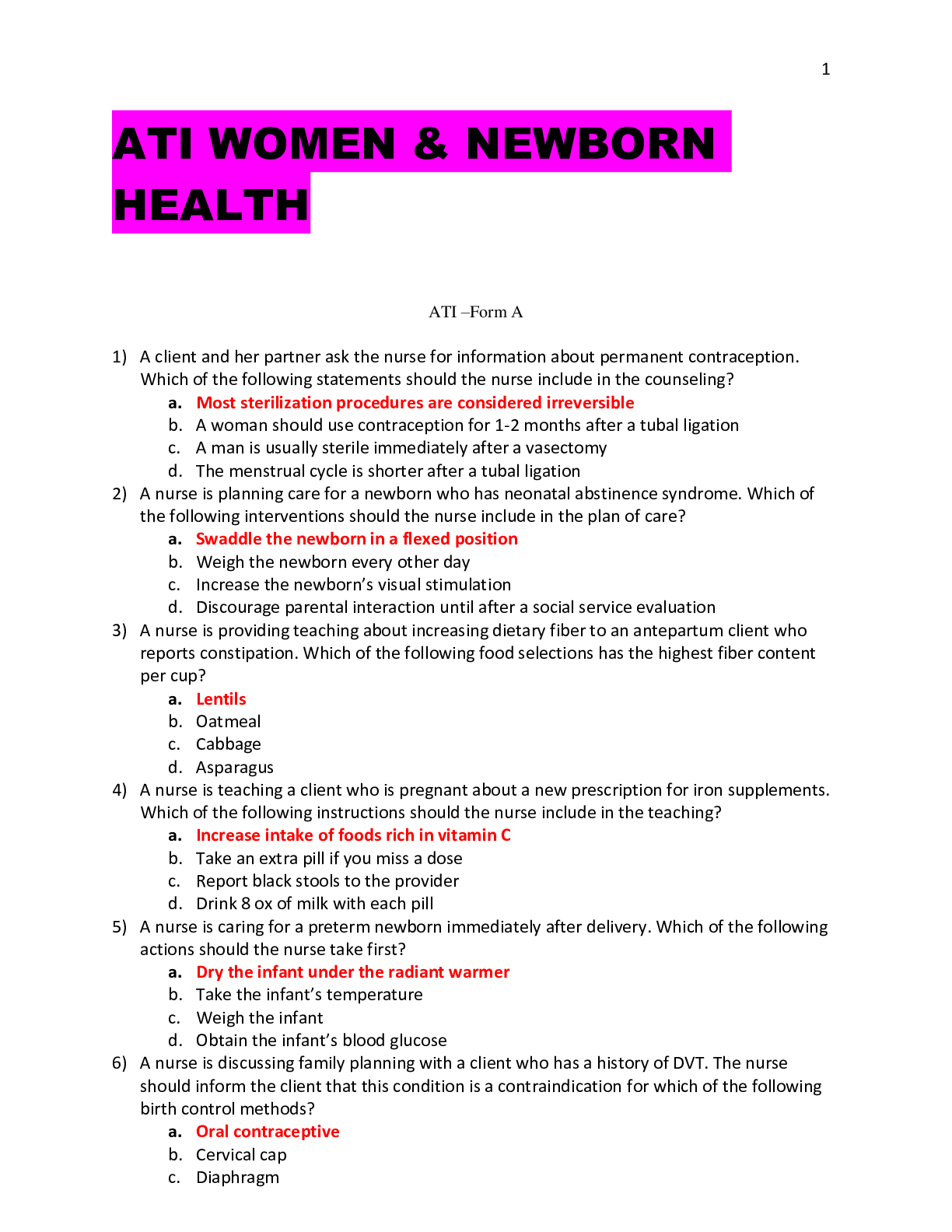
Reviews( 0 )
Document information
Connected school, study & course
About the document
Uploaded On
Jul 05, 2021
Number of pages
30
Written in
Additional information
This document has been written for:
Uploaded
Jul 05, 2021
Downloads
0
Views
104

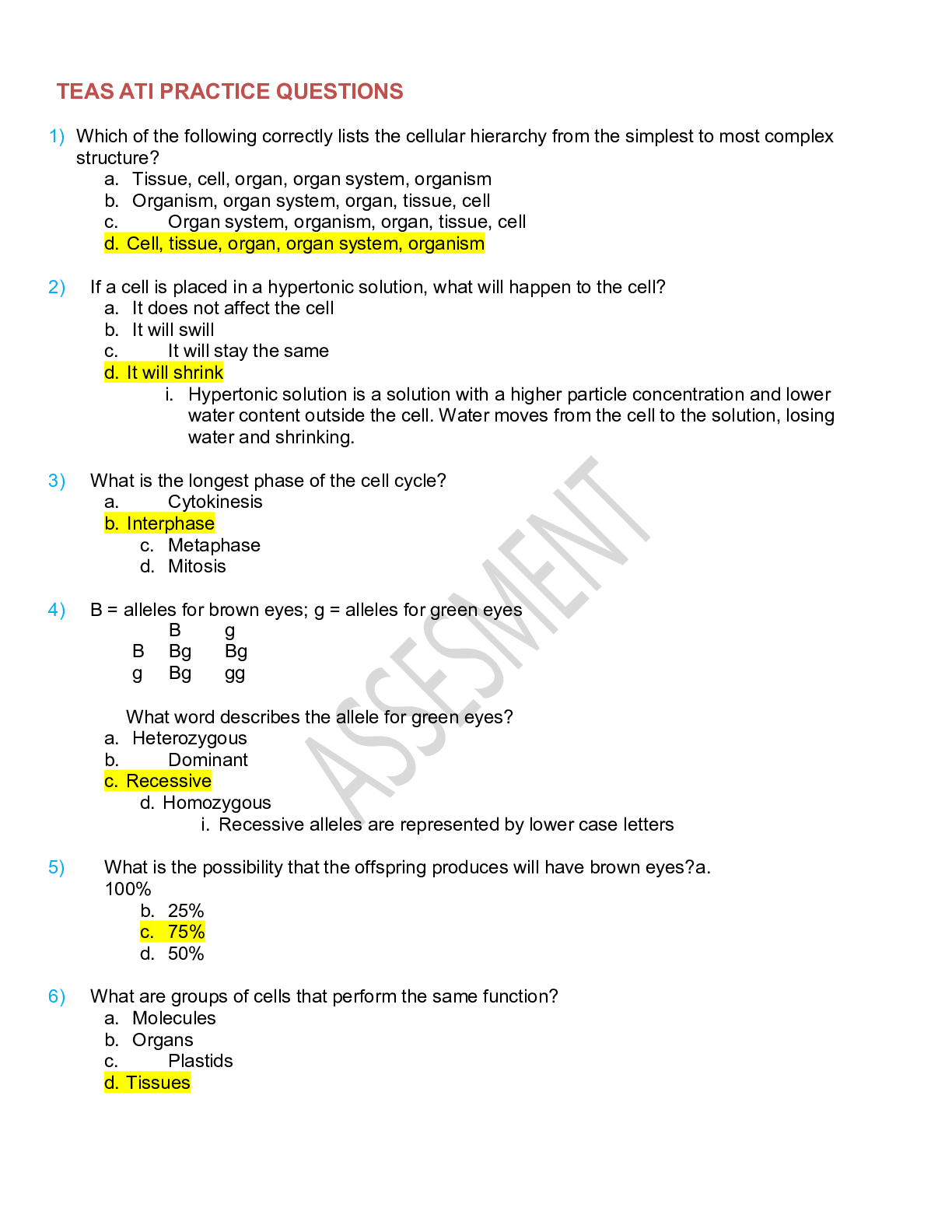
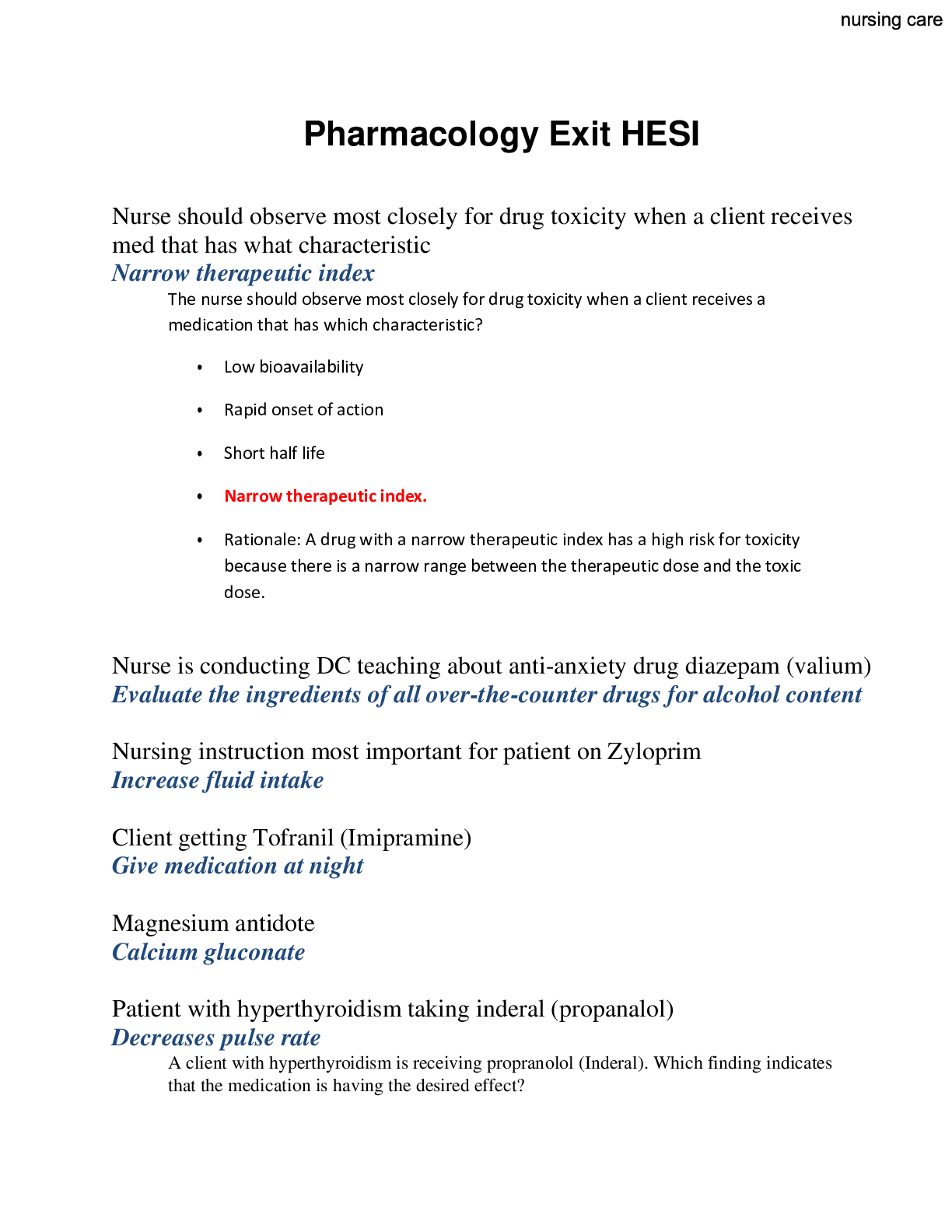

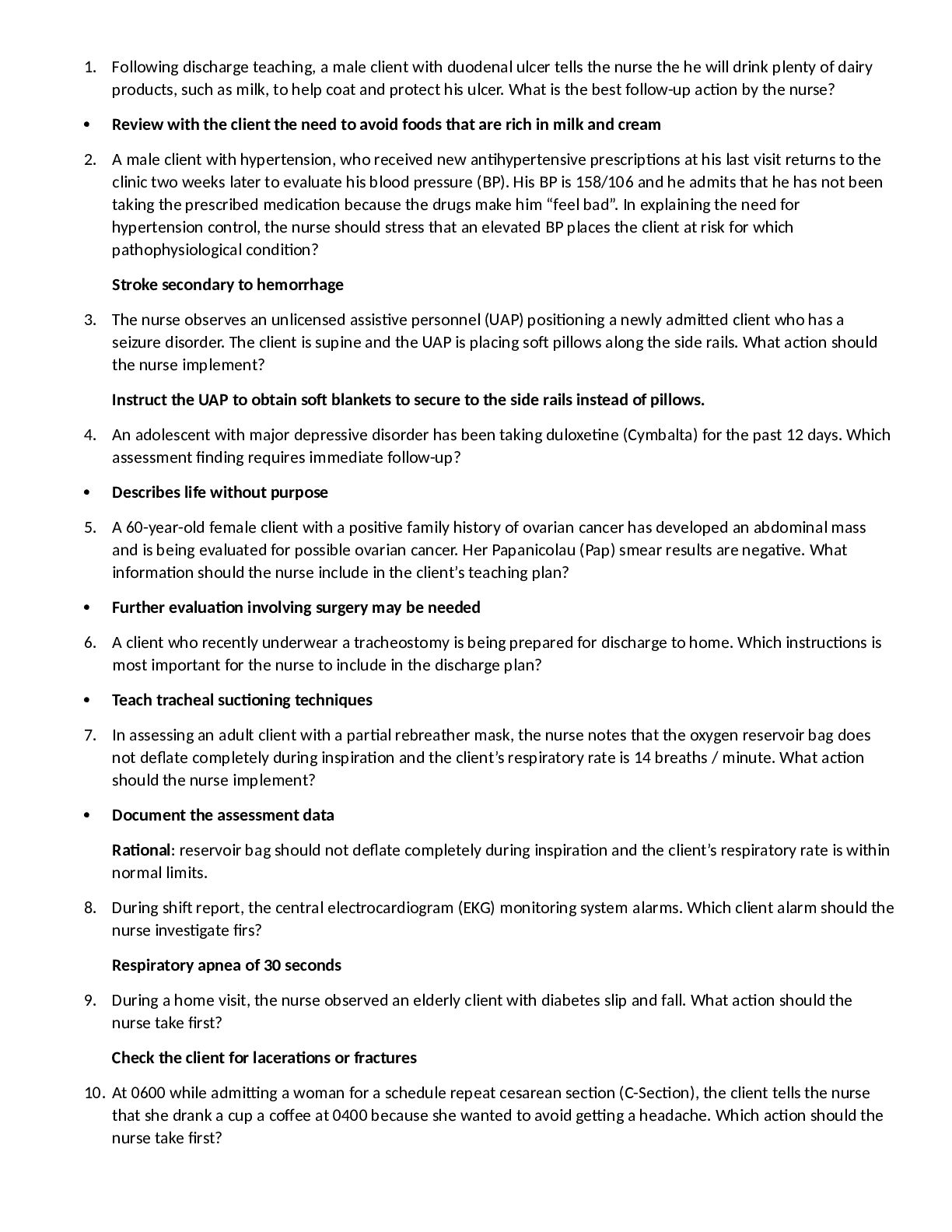
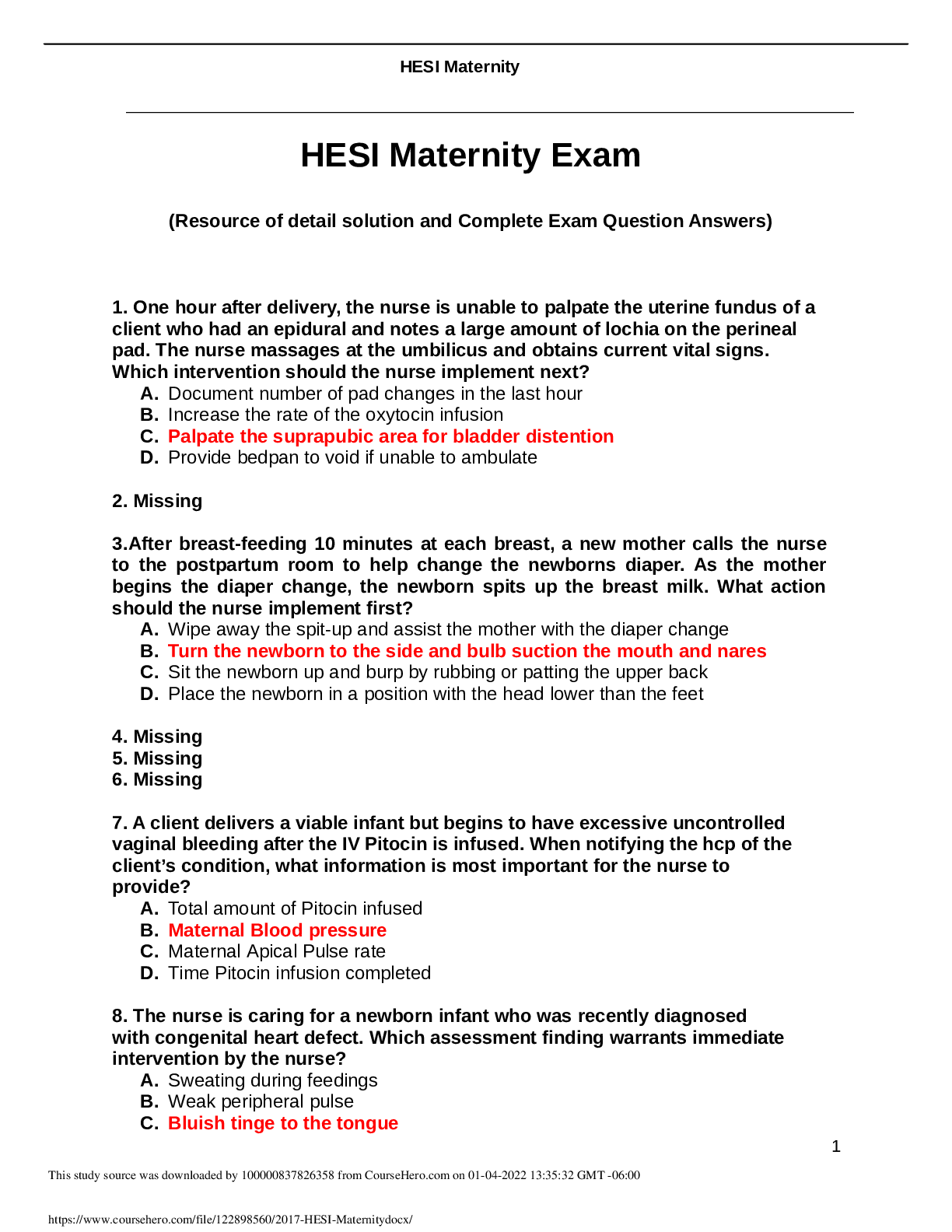
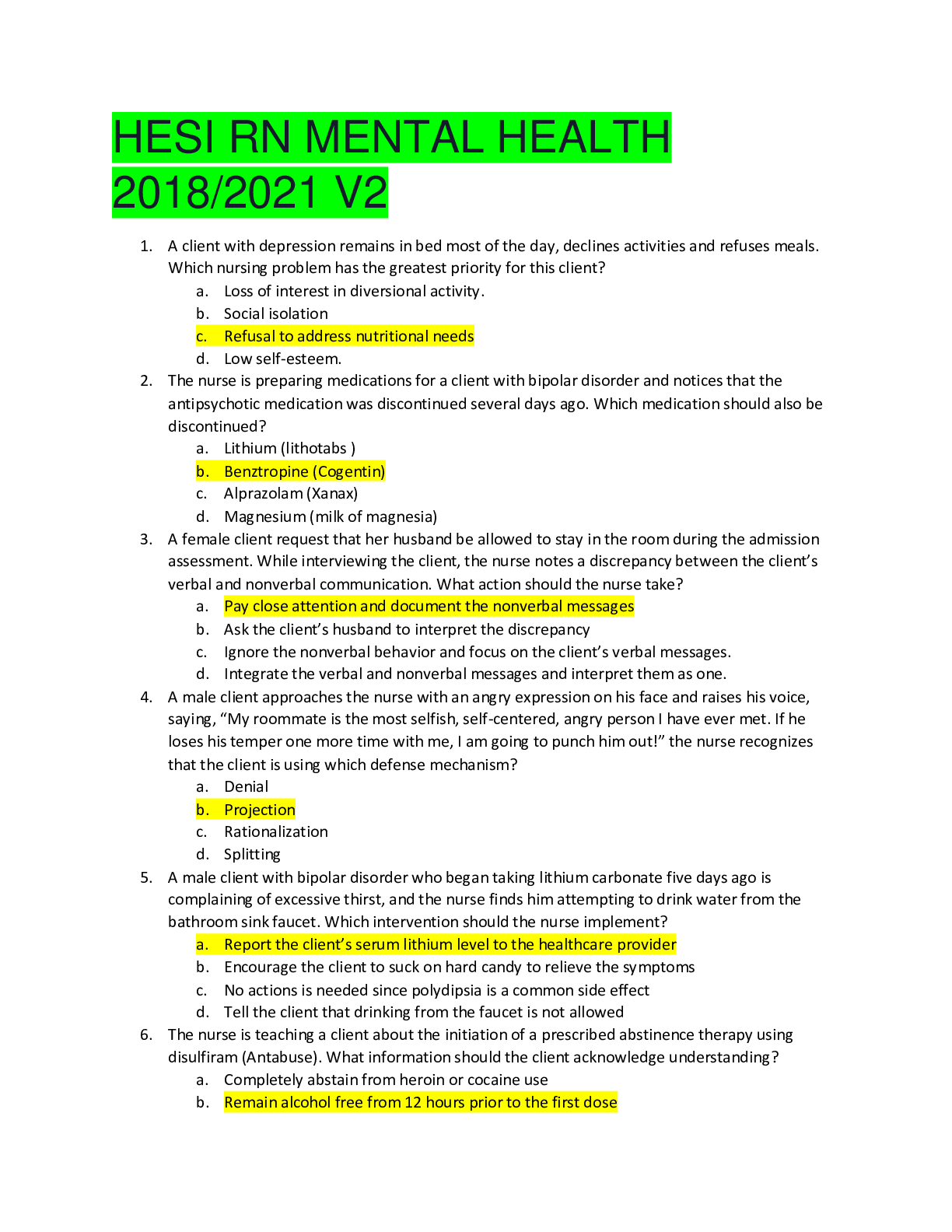

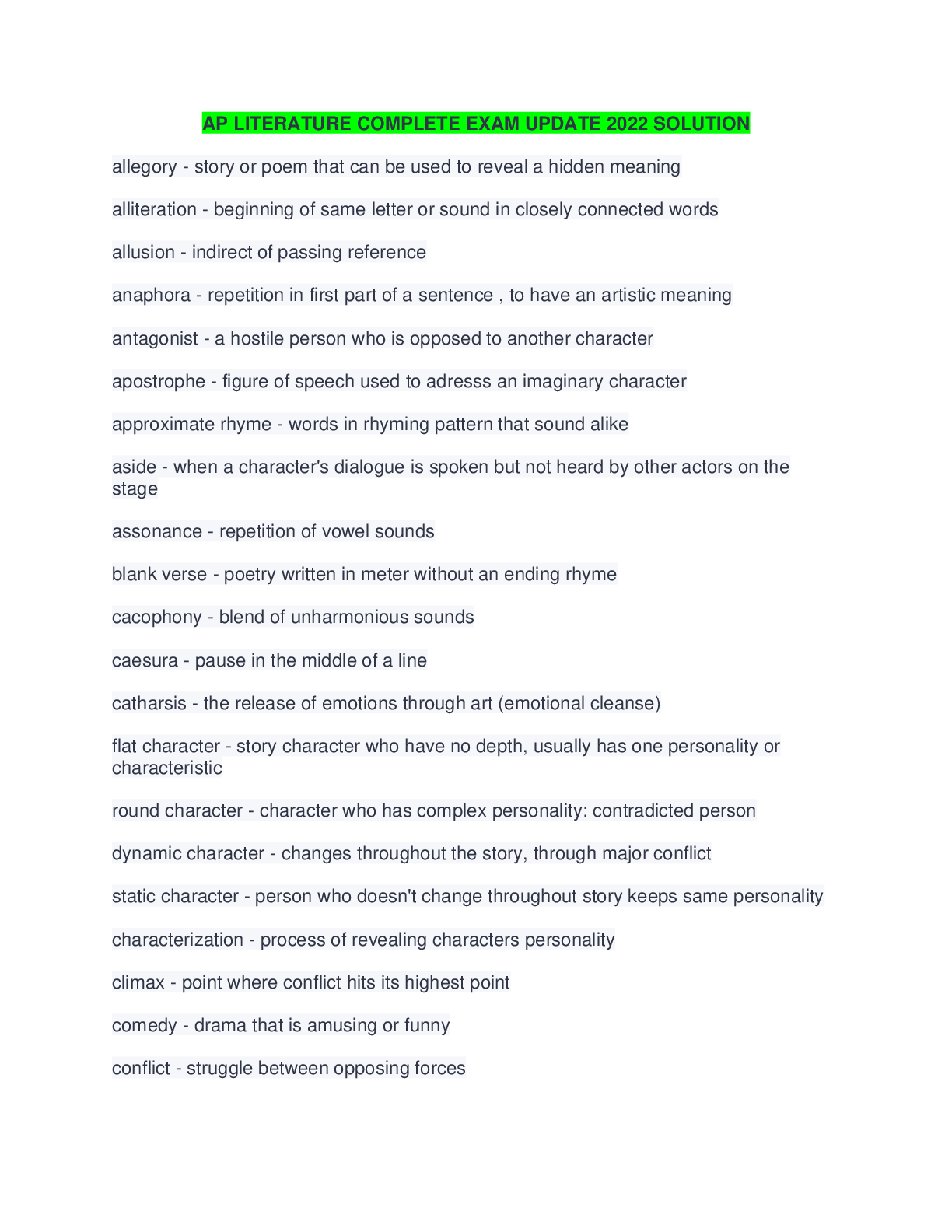
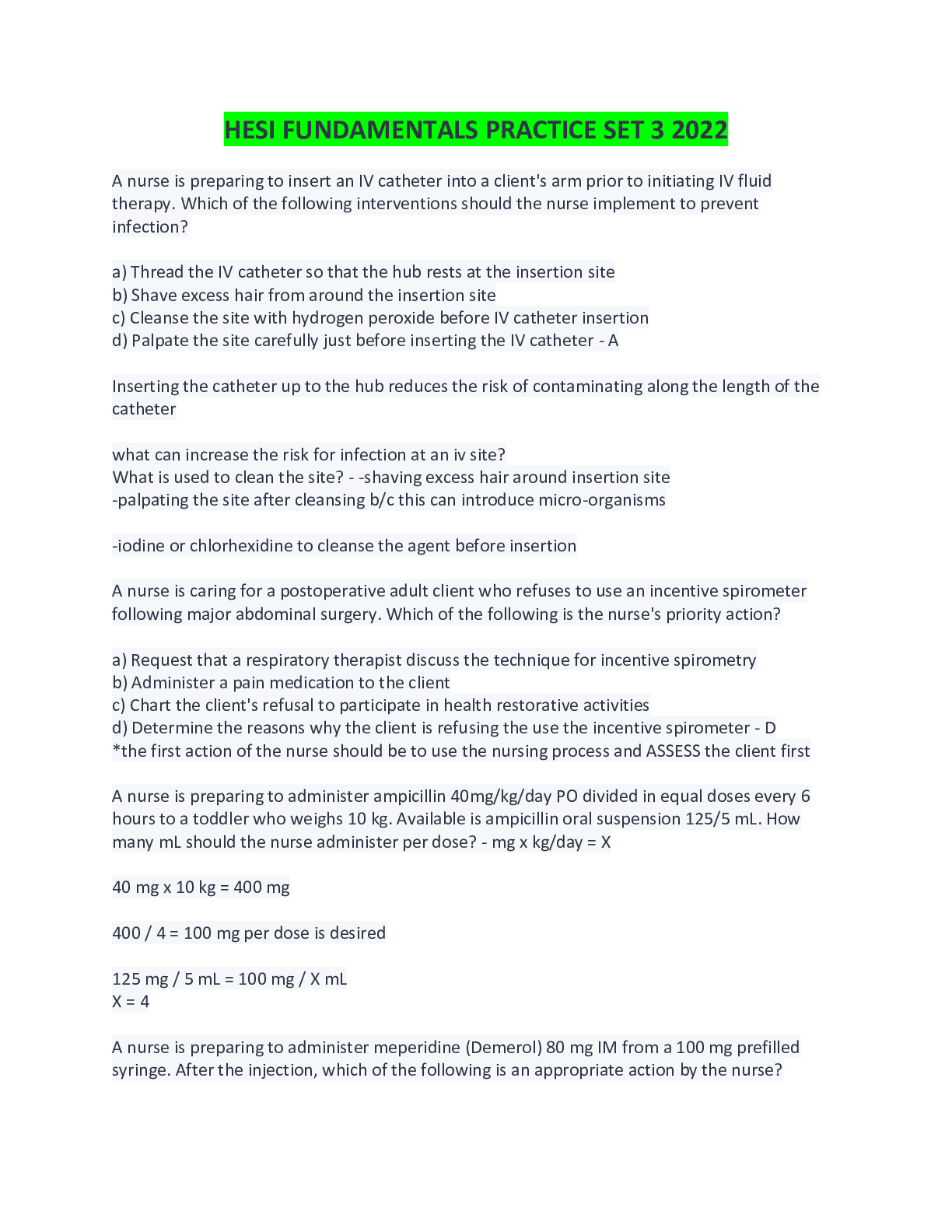
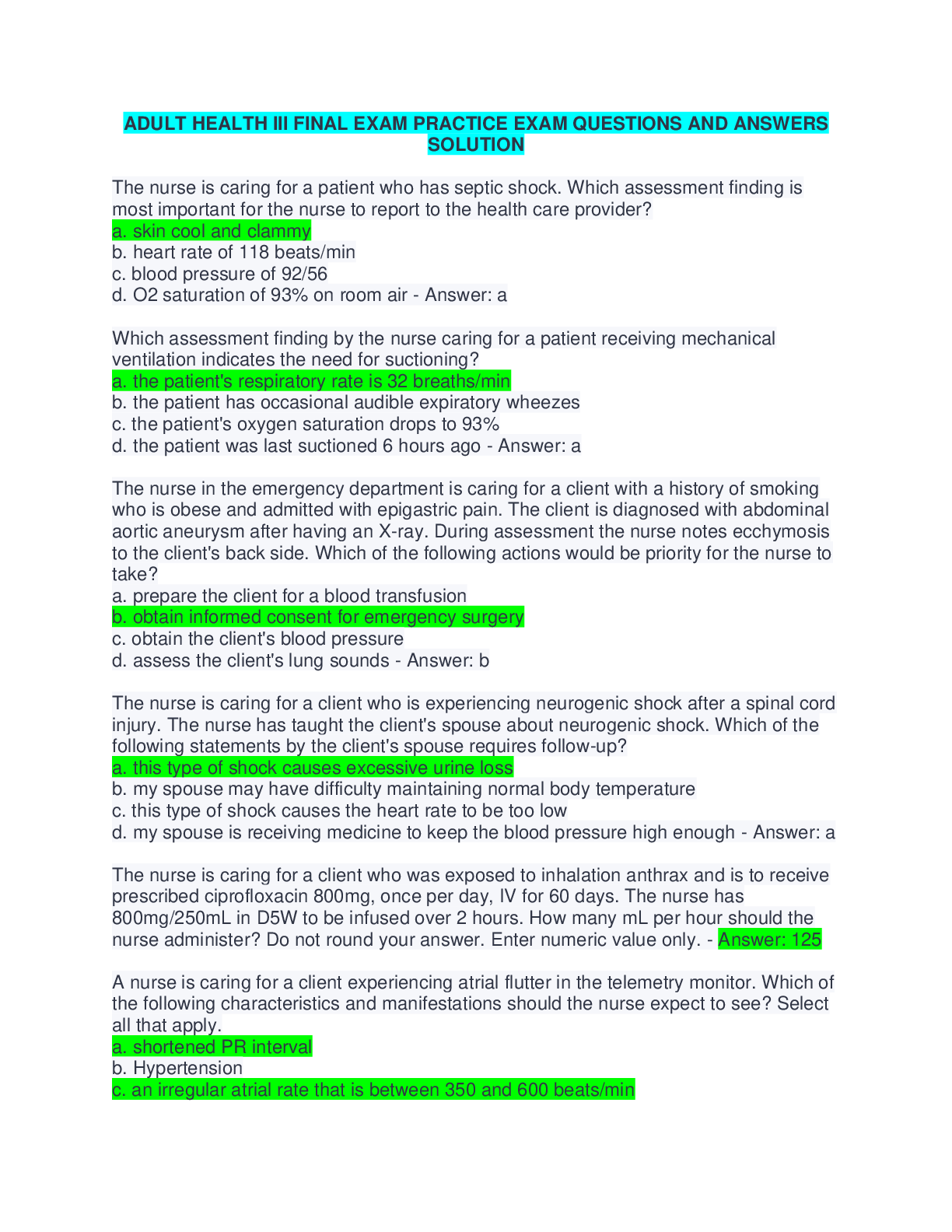

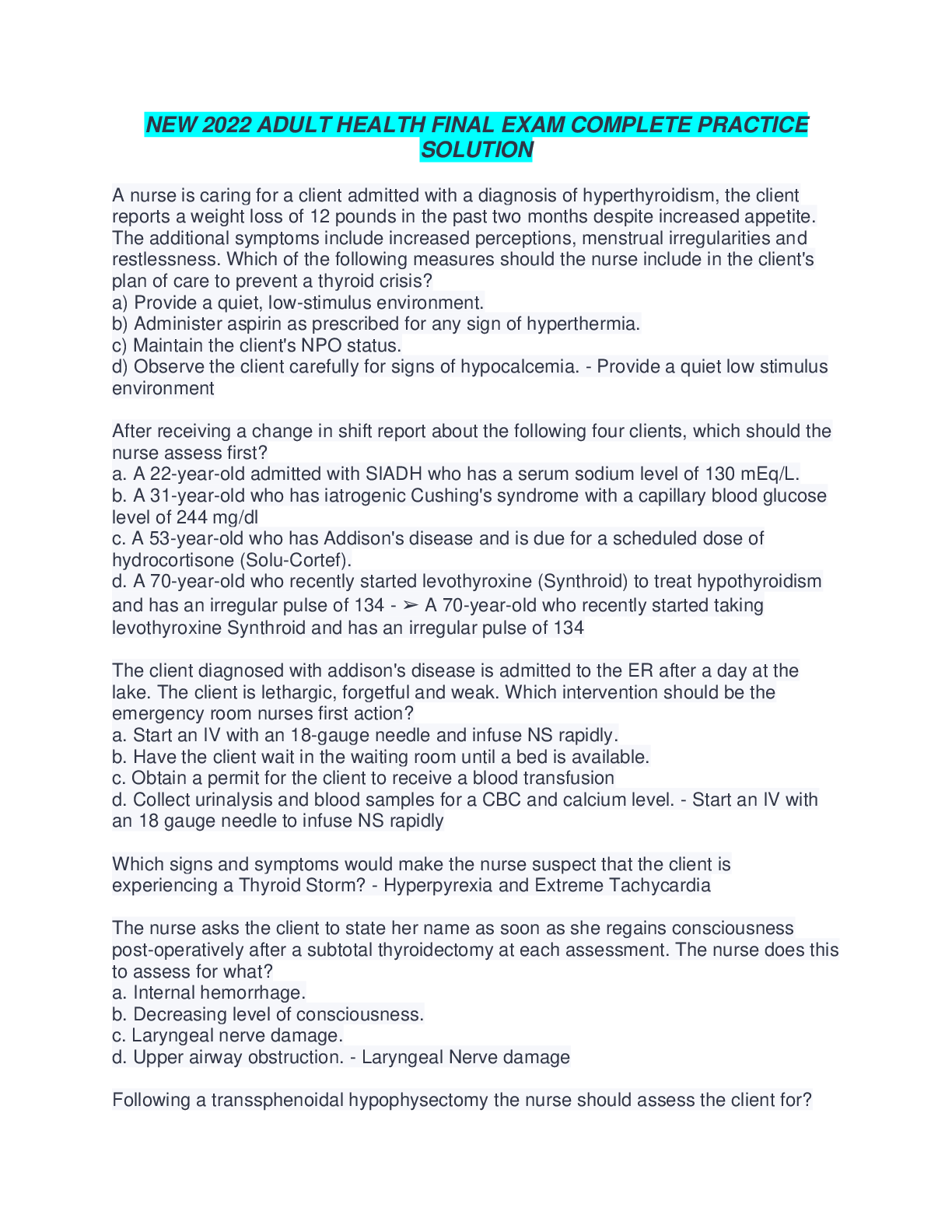
 GRADED QUESTIONS AND ANSWERS.png)
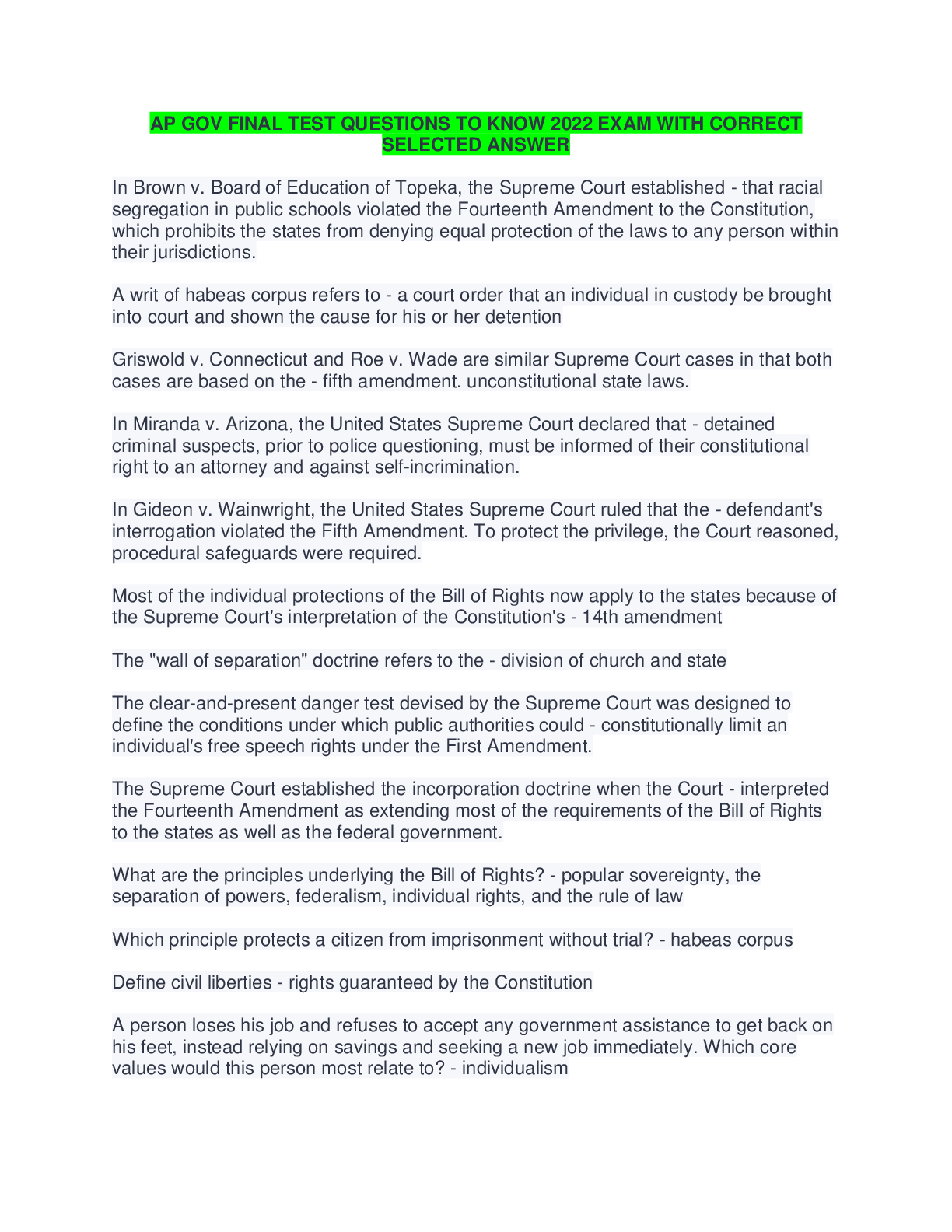
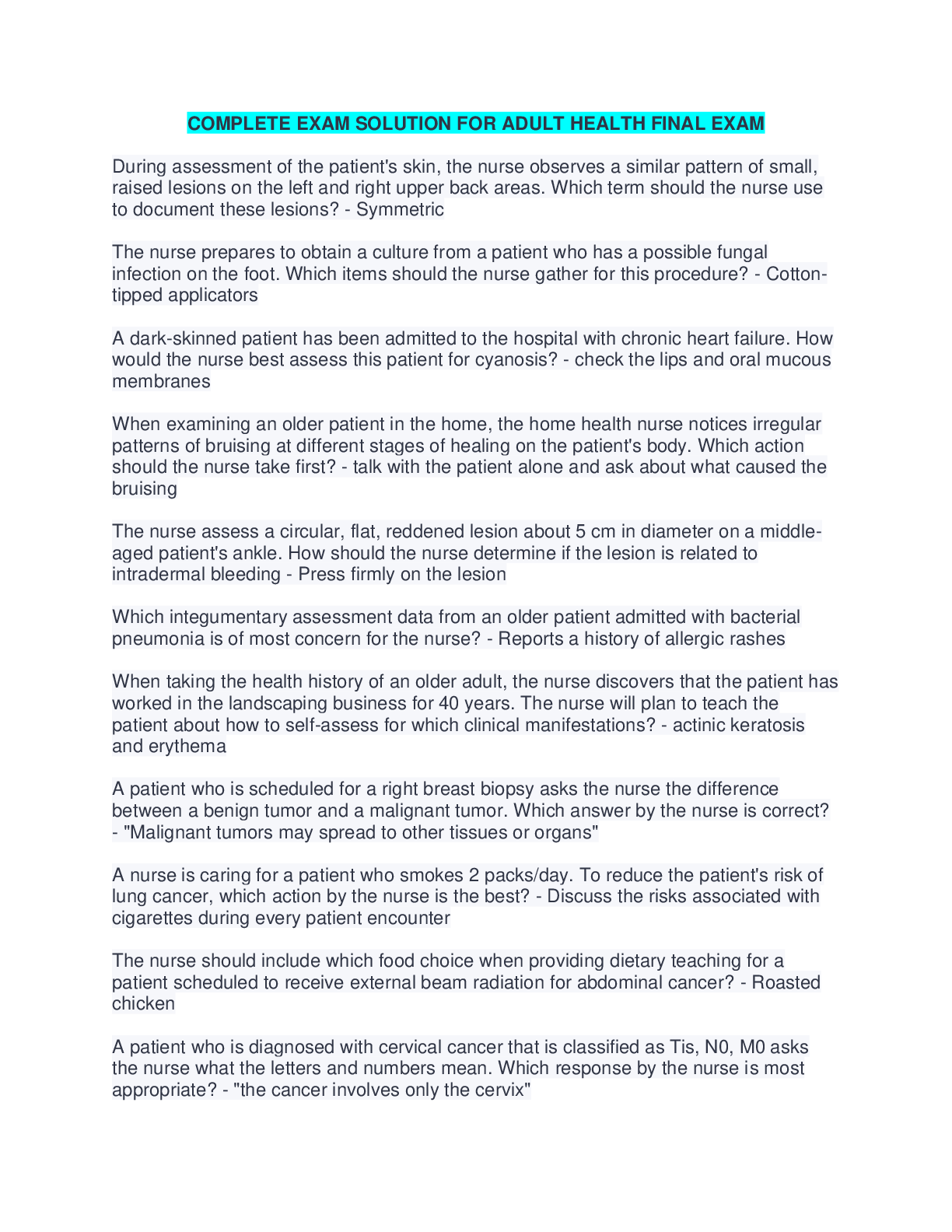
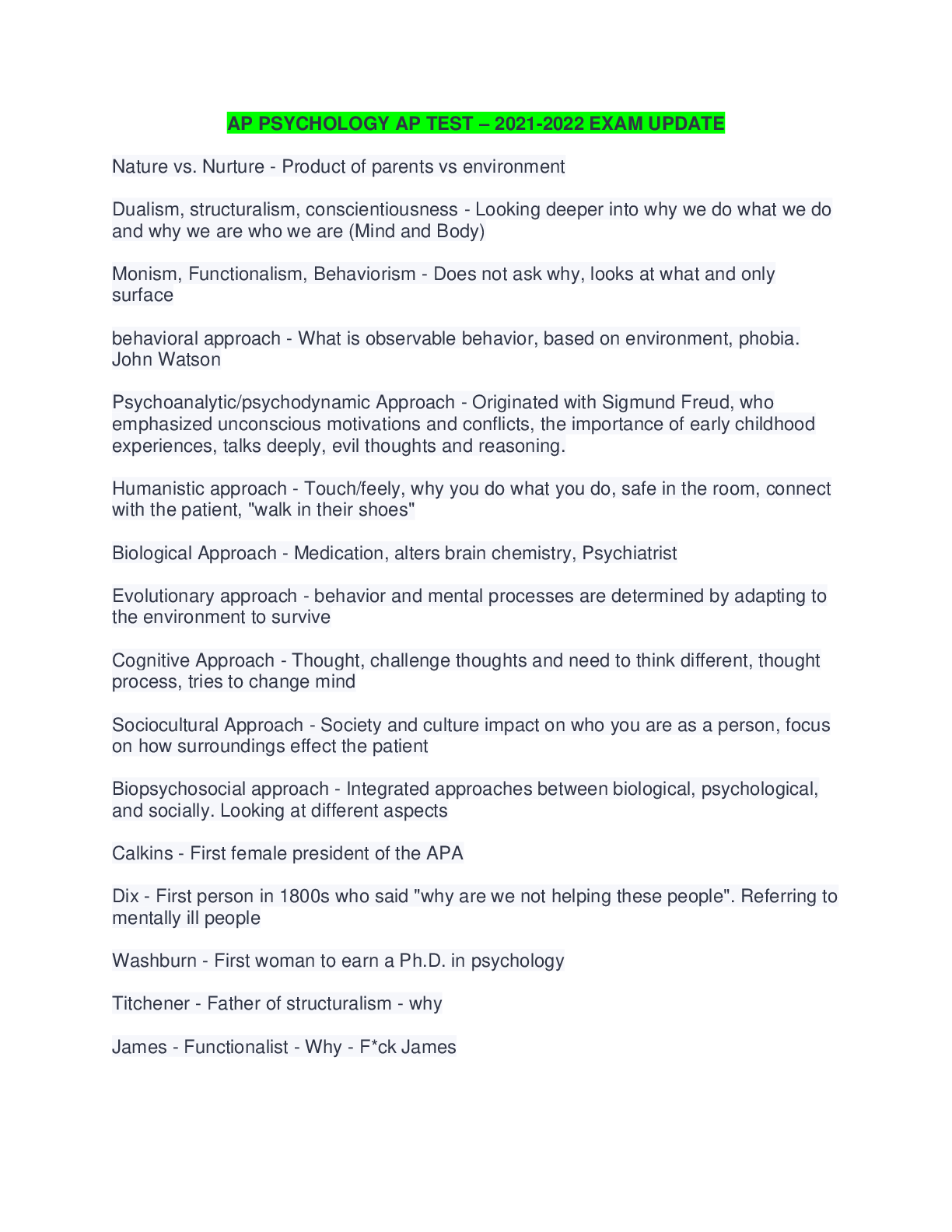



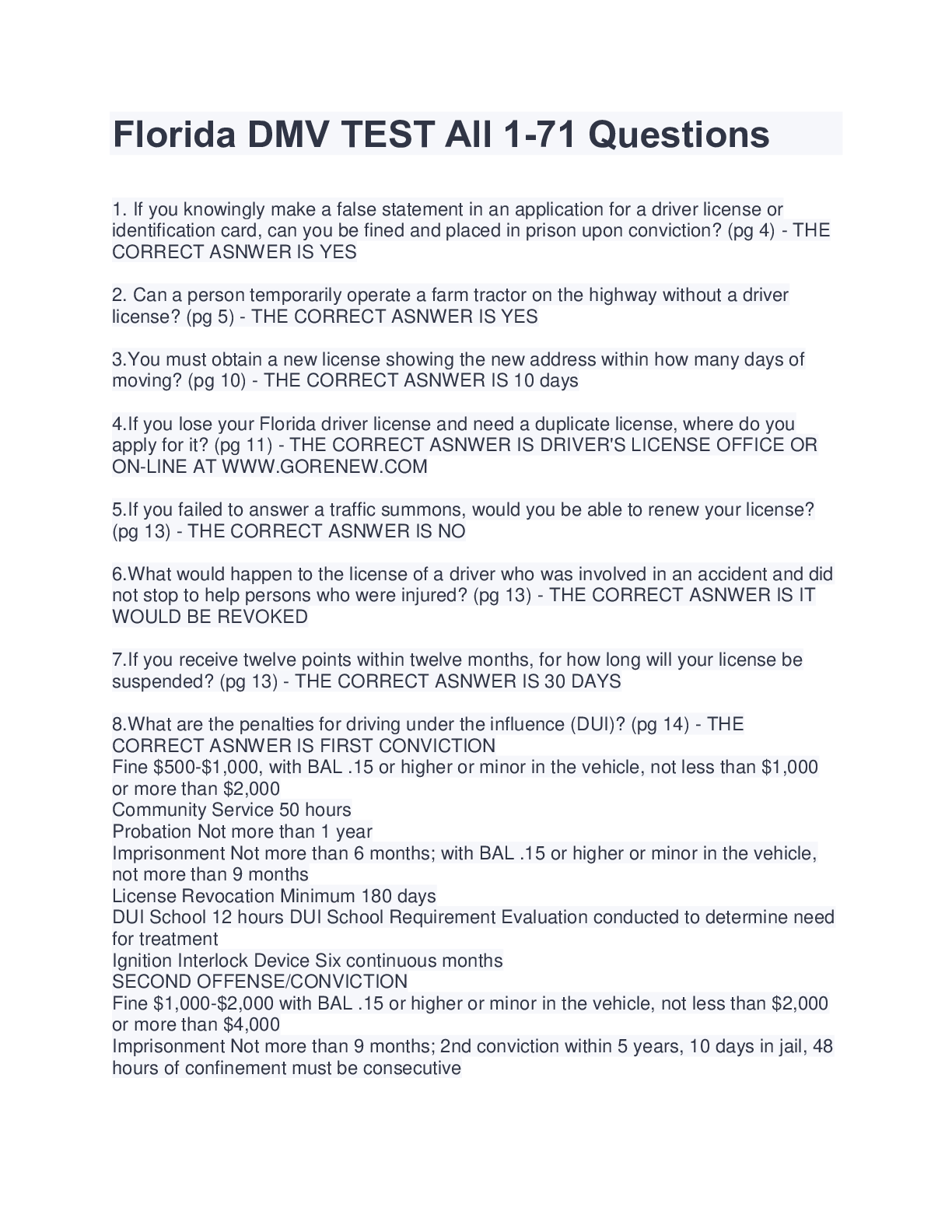
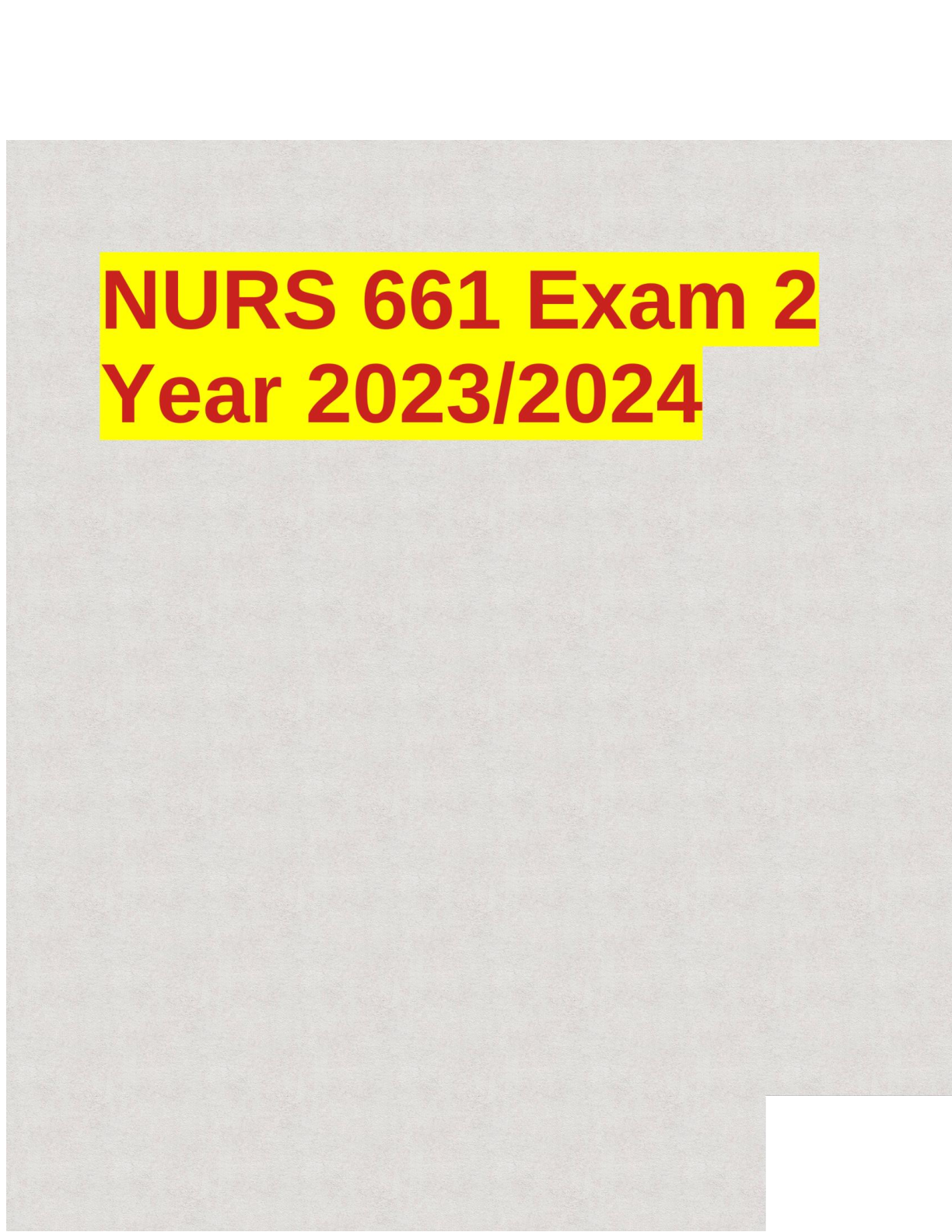

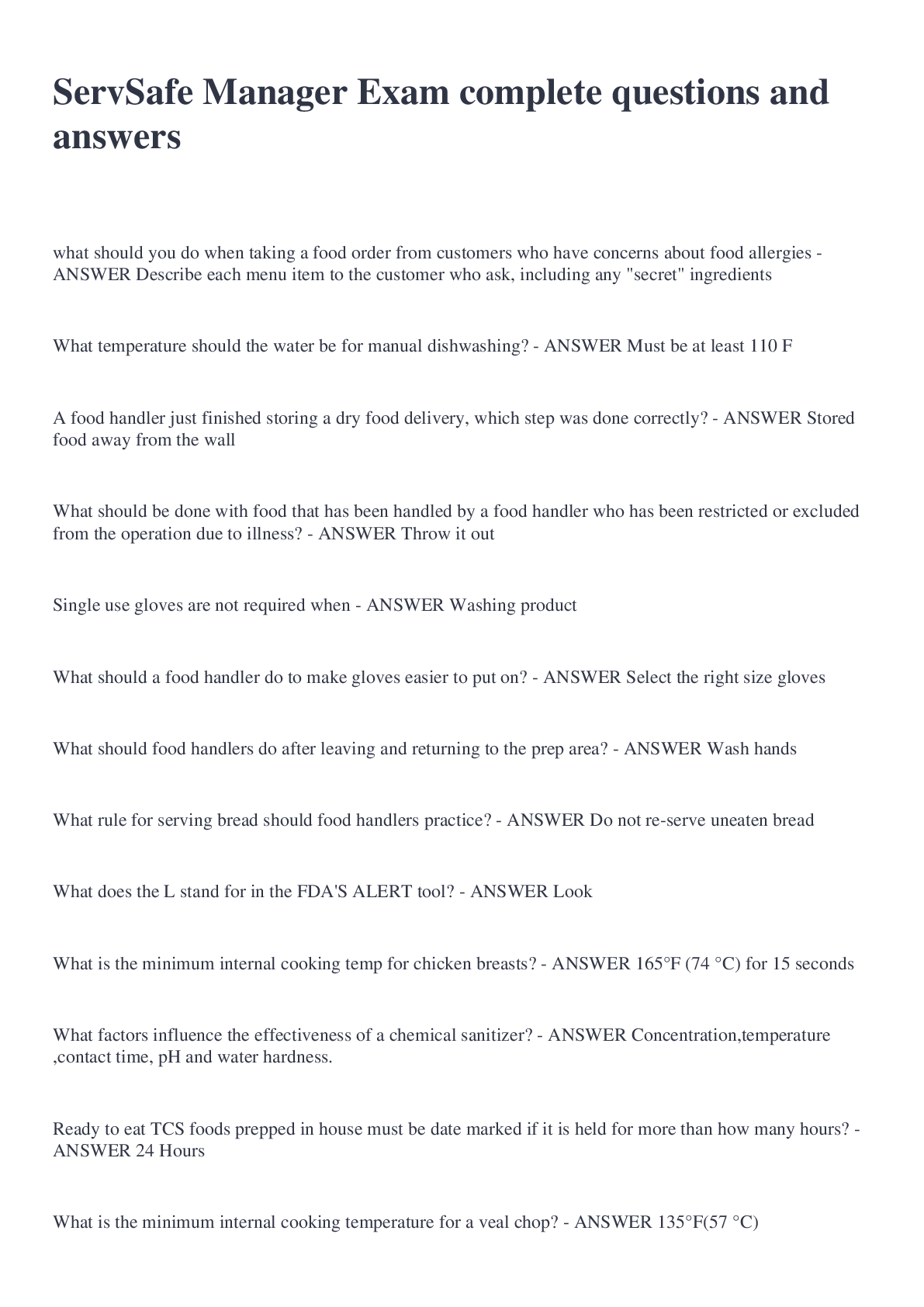


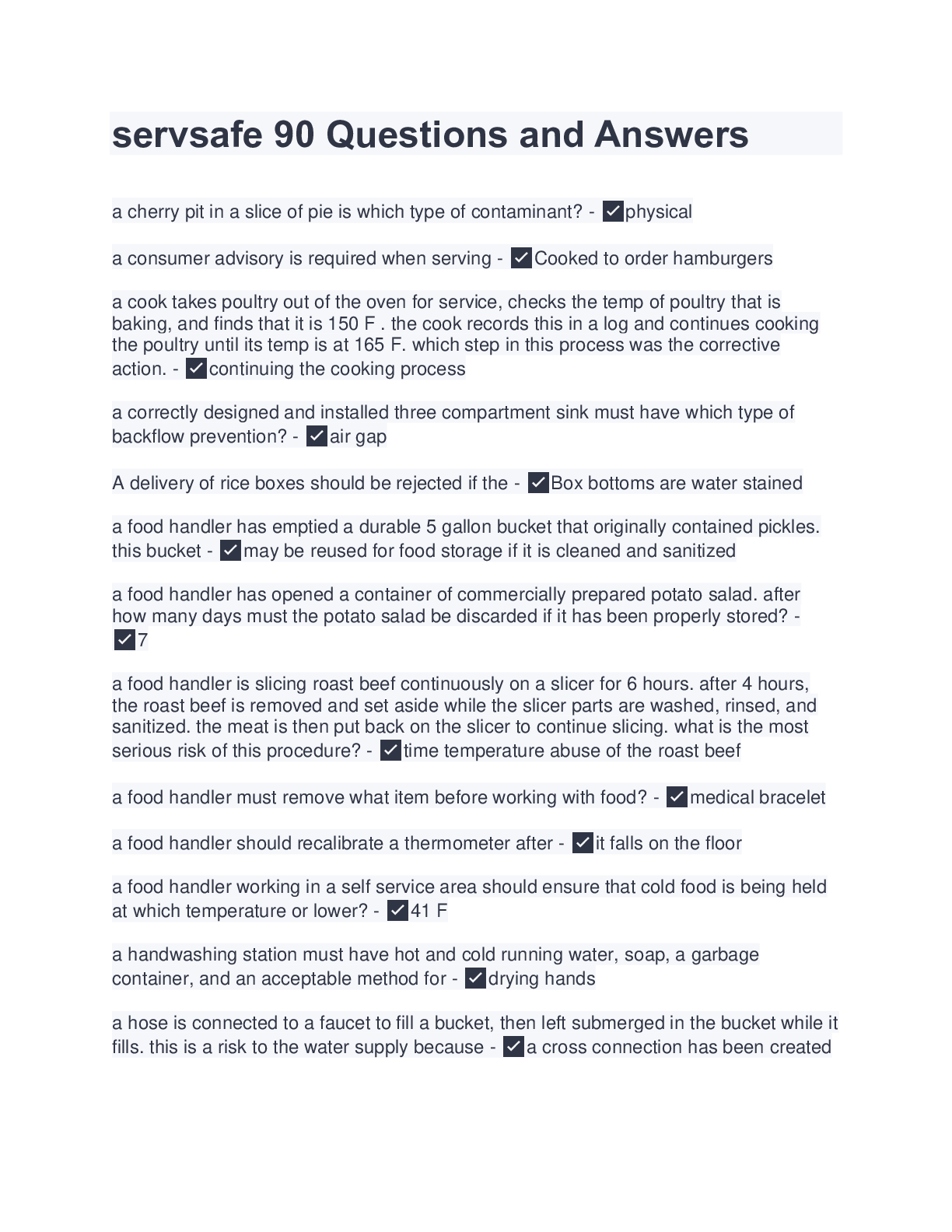
.png)


